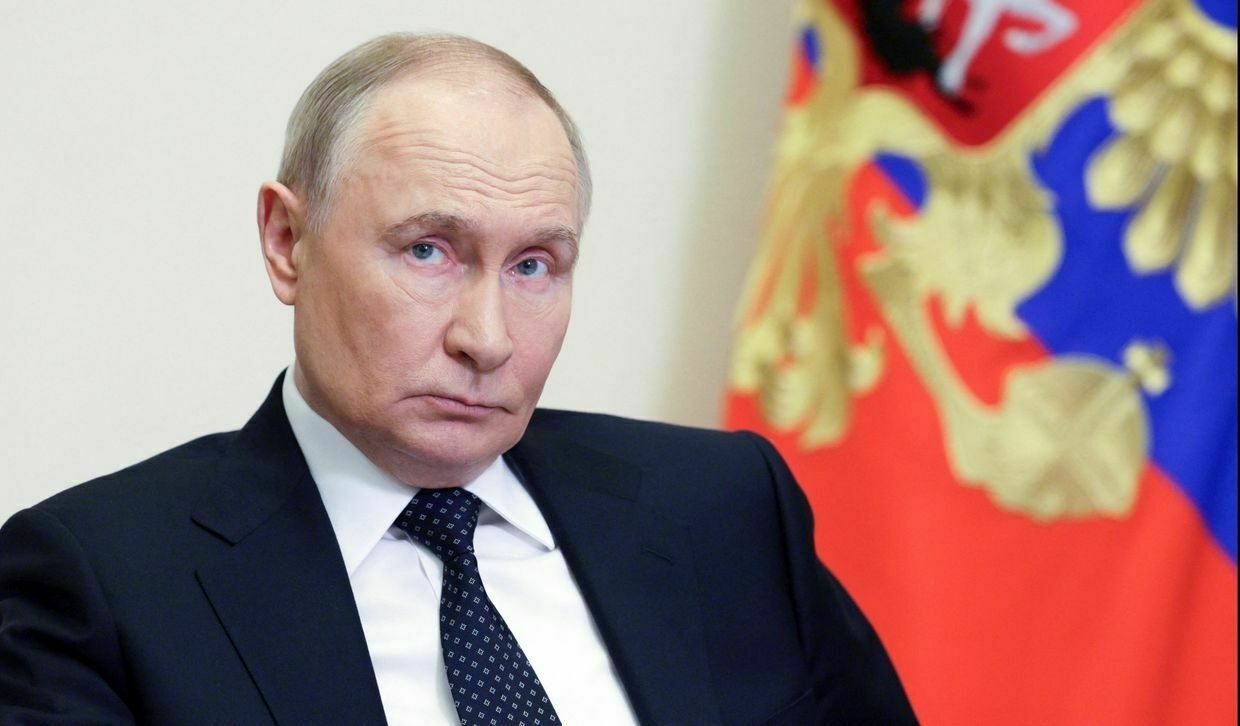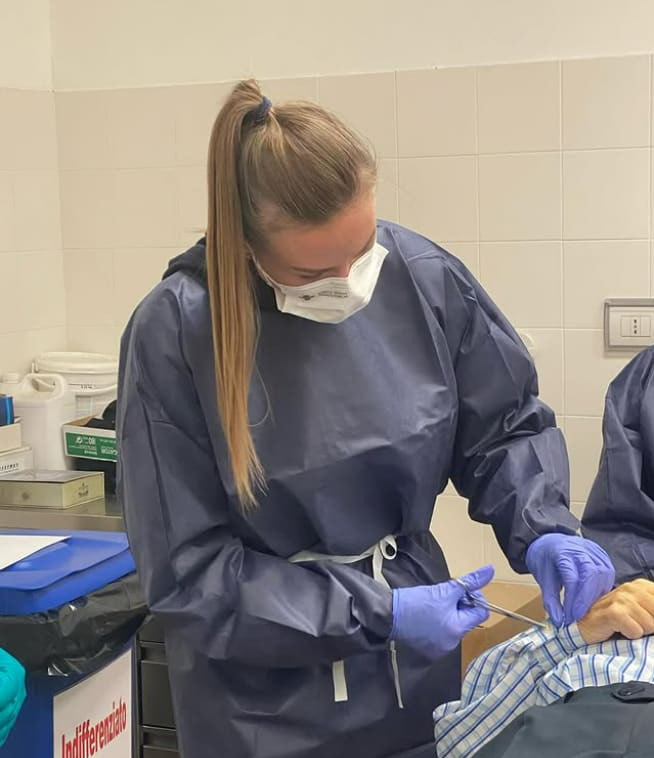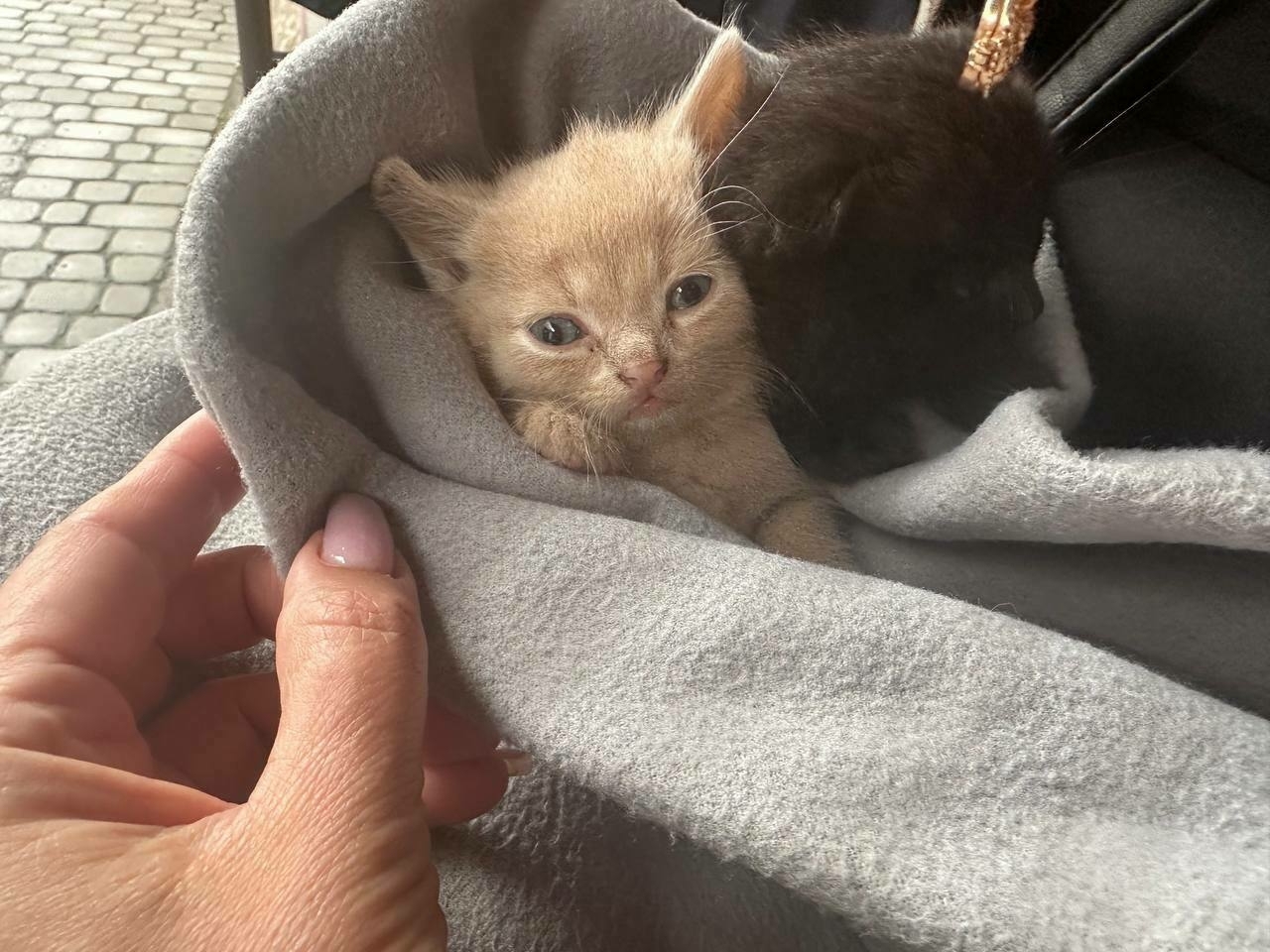-
"Ukraine is and will be" – Zelenskyy’s powerful Constitution Day speech
-
Germany reportedly scrambles fighter jets to intercept Russian spy plane over Baltic Sea
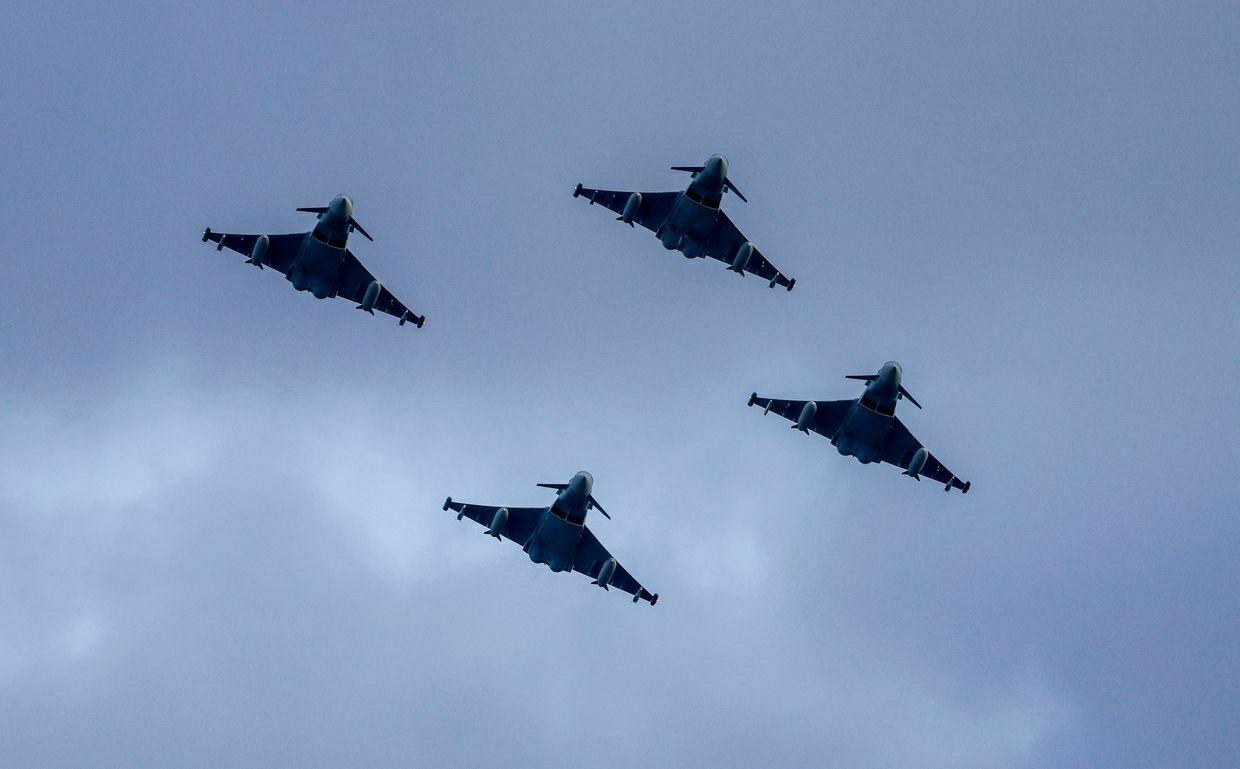
German fighter jets were scrambled to intercept a Russian Il-20 reconnaissance aircraft over the Baltic Sea near NATO airspace on the morning of June 27, the German tabloid Bild reported.
The incident adds to a series of aerial provocations reported by NATO allies since the start of Russia’s full-scale invasion of Ukraine in 2022 as Moscow is suspected of using the aircraft to spy on the alliance’s positions.
The Russian Il-20M, which took off from Kaliningrad with its transponder switched off, was headed west toward international airspace near Poland and Germany when it was detected by NATO radar systems.
NATO alerted the German Armed Forces’ Quick Reaction Team (QRT), prompting the launch of two Eurofighter jets to intercept the aircraft.
The German jets made visual contact with the Russian plane approximately 100 kilometers off the German coast and took a photograph of it. Despite the interception, the Il-20M did not alter its course.
The Russian aircraft eventually veered north, just 40 kilometers from the Baltic Sea island of Usedom, avoiding a breach of German airspace.
According to Bild, this was the ninth such interception mission conducted by German forces in 2025.
As Russia continues its aggression against Ukraine and poses an increasing threat to NATO, German Chancellor Friedrich Merz said in an interview with Süddeutsche Zeitung published on June 27 that he would refrain from phone calls with Russian President Vladimir Putin given the intensified attacks on Ukraine.
Merz’s predecessor, Olaf Scholz, was the first EU leader from a country supporting Ukraine to resume direct contact with Putin since the start of the full-scale invasion, speaking with him by phone in November 2024.
Ukrainian drone strike on Crimea air base destroys 3 Russian helicopters, SBU claimsThe attack destroyed Mi-8, Mi-26 and Mi-28 attack helicopters, and a Pantsyr-S1 self-propelled anti-aircraft missile and gun system, the Security Service of Ukraine told the Kyiv Independent. The Kyiv IndependentKateryna Denisova
The Kyiv IndependentKateryna Denisova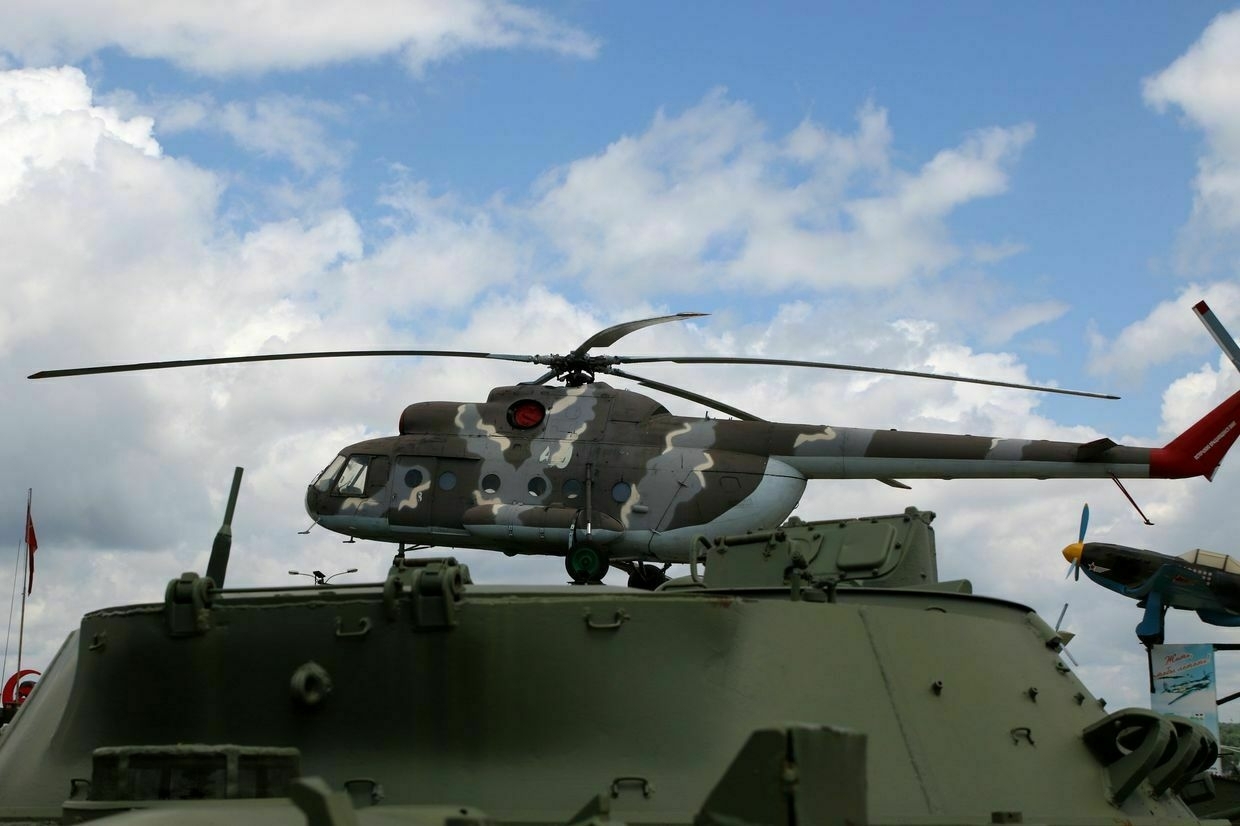
-
The most heart-wrenching job in Ukraine
Editor’s Note: We’re raising funds to get every member of The Counteroffensive team a sleeping bag, foldable cot, ear plugs and eye mask so they can get some sleep amid these dramatically increasing attacks in Kyiv.
We also cover every member of our team and their mental health therapy sessions. Support us now if you agree with our approach.
DISCLAIMER: This story includes descriptions and images which may be disturbing for some readers.
“Masha, get up. Masha, don't sleep, get up!”
The mother’s scream over her child’s coffin will echo in Olena’s mind forever.
Olena is far from being the most emotional person in the room. After all, working with the dead is what she does.
Her job is to hide the traces of war on the dead children's faces, to make it look as if the child had simply fallen asleep, rather than having been hit by a Russian missile.
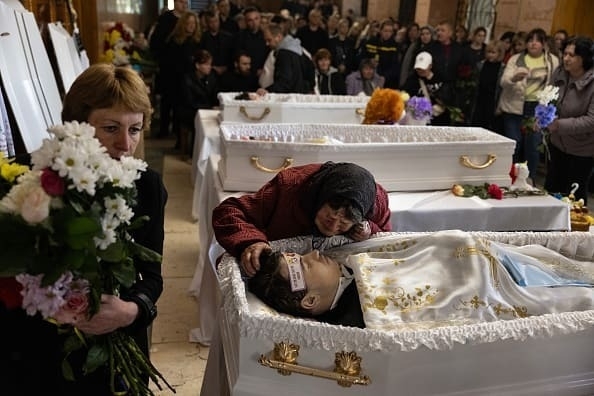
A grandmother says goodbye to her grandson, Roman Martyniuk, 17, who was killed along with his siblings Tamara and Stanislav when Russia launched a massive aerial attack on May 25th. (Photo by Paula Bronstein/Getty Images). Olena arrives at the funeral home ‘Ceremonial’ in Dnipro, puts on gloves and a disposable jumpsuit, and heads to the assigned child-sized coffin.
“It is not easy. But it allows people to say goodbye in an open coffin,” she said. “It's nice to hear the words… ‘She looks like she's just sleeping.’ That means I did my job well.”
Russia has killed at least 631 children and injured nearly 2,000 since the start of the full-scale invasion. The Kremlin has long been targeting bomb shelters marked ‘children,’ most famously at Mariupol’s theater in 2022, which was specifically marked with the word ‘children.’
In the past three months, Russia has killed 15 children and wounded more than 100. In addition, Russia is stepping up its drone attacks on Ukrainian cities. In two weeks in June, the number of drones launched equaled what would normally take place over months.
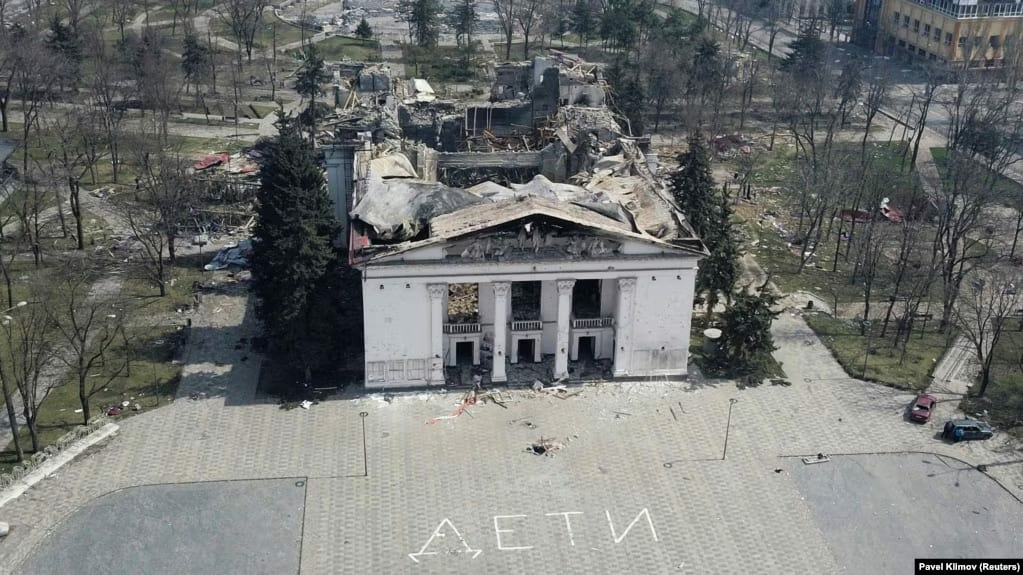
The Drama Theater in Mariupol on April 10, 2022 after it was bombed. The word ‘children’ was written in large letters on the square in front of the theater. Photo Pavel Klimov/Reuters. The ongoing war has forced Ukrainians to find ways to preserve the memory of the dead, in particular their children, by ensuring they receive a proper burial. The care for society’s most innocent – the youngest among us – says something not only about Ukraine’s views towards children, but also the way they view the vulnerable more broadly.
People who work with the war casualties every day, such as Olena, have no time to be scared or to grieve: they must continue to work for over tiny coffins.
Olena Holotsvan is one of the few thanatopractitioners (a person who restores traumatized faces before burial) in Ukraine. She has been working for more than six years, restoring the facial features of the deceased to prepare the bodies for the burials.
"I work with the skin on the outside and inside,” she said. “I do this so that relatives are not afraid to look at their deceased loved ones in the coffin. This is very important for them, especially for parents who are saying goodbye to their children.”
Her workplace resembles a small operating room. In the middle of the room stands a table with a body lying on it, surrounded by various instruments and cosmetics, which Olena uses to restore the shape of the face and the skin color. If the body is delivered quickly after death, and it is not badly damaged, the work will take a maximum of 90 minutes.
Olena has been intrigued by the morgues ever since she was a child, though she can’t explain why. When she was 30 years old, a friend offered to take her to one, and Olena could not refuse.
Fascinated by the experience, she later enrolled in courses to not only be able to perform autopsies, but also restore the faces of the deceased. That's how her career in the morgue began.
Before the full-scale invasion, bodies mostly just needed cosmetics. Yet, amid receiving bodies that have been hit by Russian drones and missiles, she needs to spend more time in restoration, as she has to cover deep cuts and hide burns.
“It is important for parents to see the body and face of their deceased child,” clinical psychologist Yana Hryvchuk told The Counteroffensive. “That is why it is important to bury them in an open coffin, otherwise a person may not accept the death of their child and live their whole life hoping that their child is still alive.”
Since the start of the invasion, Olena’s focus shifted to treating children killed by Russian attacks. In this way, Olena does more than just a mechanical task; she’s more than just a cog in the machine of burial. She helps people find closure.
In Ukraine, it is customary to bury people in an open coffin. This allows people to say goodbye to the deceased by kissing or touching them one last time.
Closed coffins are used in rare cases when the body has been severely damaged in serious accidents. This can cause relatives to doubt whether it is really their loved one who has died. Such doubts arise especially when it comes to bodies that are traumatized beyond recognition.
A man collapses to the ground after the body of a boy was recovered from the rubble of a building in Kyiv. His parents had been hoping for his rescue all day, on June 17, 2025. Video by TSN.
Olena remembers vividly January 14, 2023, when Russians hit a residential building in Dnipro with a ballistic missile, destroying every floor of the building, and killing over 10 people.
She rushed to the funeral home with her friend Anna Gryshyna and her husband, who were there as volunteers.
"Six children died. Another 11 people are still missing because their bodies simply evaporated from the heat after the explosion. And then we at the agency decided that everyone who came to us for burial would be buried free of charge, in nice lacquered coffins, with all the necessary services," Anna told The Counteroffensive.
The first to contact their funeral home that day was Masha's mother. Masha was a 15-year-old girl who died after Russia hit the building that January. Anna took care of the funeral arrangements, while Olena prepared the body.
Preparations for the funeral usually take about three days. During this time, the parents choose a coffin and other items they believe their child would have liked, Anna recalled:
“Almost all parents behave the same way. They focus all their attention on details and every little thing. It's as if they are planning a surprise for their child's birthday, only in reverse.”
Parents usually choose a white coffin for their child, to represent the bright memory of their child.
“For parents, organizing a funeral involves rituals that allow them to gradually accept their loss. At the same time, it is an opportunity to create a place of remembrance where they can come and remember their child,” explained Yana Hryvchuk.
Olena is not typically an emotional person. “It makes no difference to me whether I work with children or adults. The only thing is that children have better skin, so it's a little easier to work with them,” Olena said.
To keep her mind going throughout the day, Olena reminds herself that it is not her fault the child is dead.
In addition, she tries not to talk to relatives of the deceased, to avoid seeing their emotions toward the child who, just a few days ago, was sitting in a school class or playing in a kindergarten playground.
But when Olena was working with 15-year-old girl Masha, things didn't go as planned. Masha was lying in a coffin with her makeup done. Olena, after concluding her work, was getting ready to leave when Masha’s mother entered the funeral hall.
Masha’s mother fell to her knees in front of the coffin and began to scream. She couldn't believe that her daughter had died. The woman didn't get up and continued screaming for over an hour.
"I realized that a tragedy had occurred. And these are the consequences of what is happening. When you live in a war, it becomes blurred; you get used to everything," Olena said. But at that moment, I realized that the war and its consequences were close by.”
The most challenging part of any funeral is when they close the lid of the coffin.
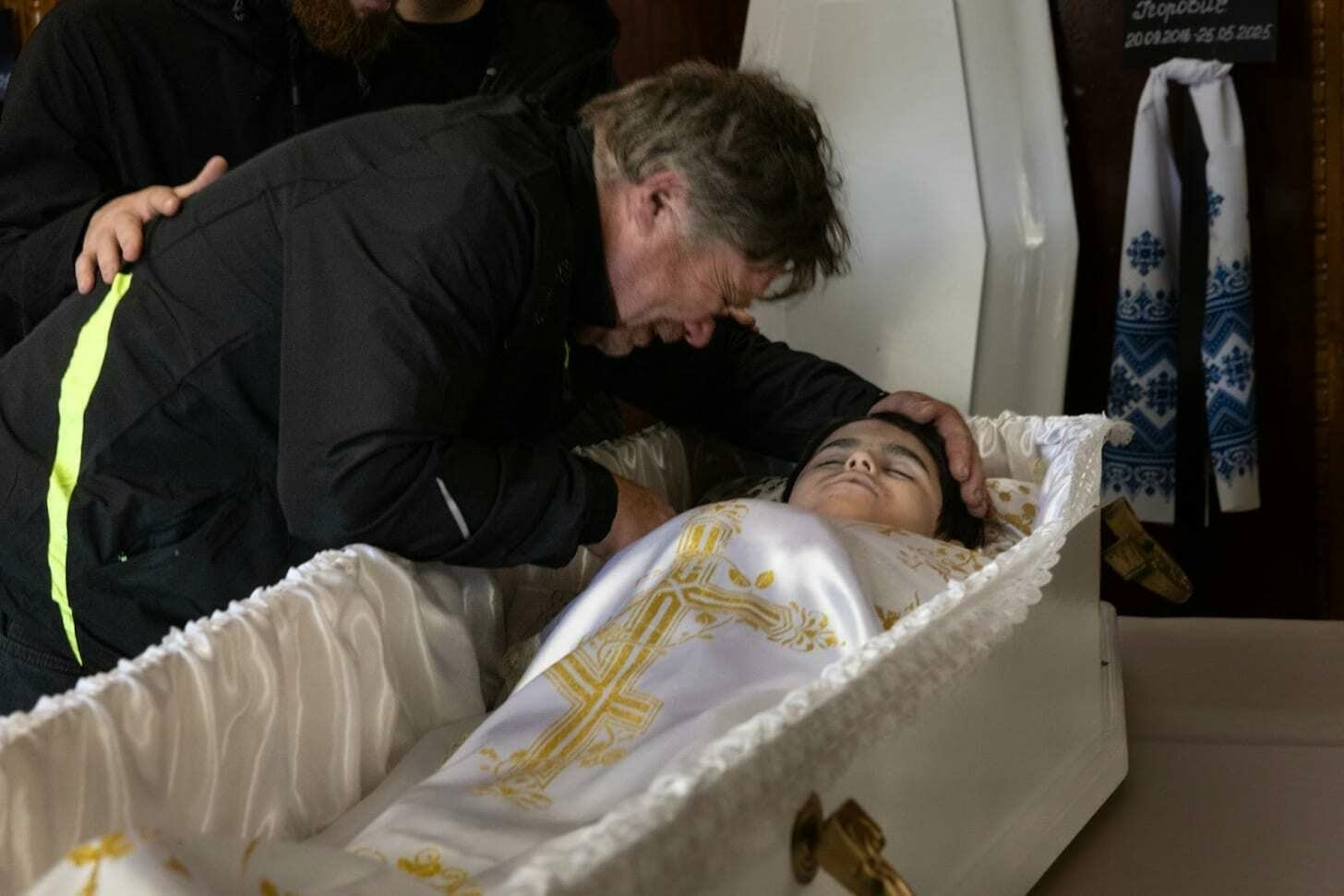
Ihor Martyniuk says goodbye to his daughter Tamara who was killed along with his two other children when Russia launched a massive aerial attack on May 25th across multiple cities. Photo by Paula Bronstein/Getty Images. Many mothers faint or become hysterical. Anna, Olena’s colleague, advises always having a doctor nearby.
“When the coffin is closed, parents realize that this is the last moment they will see their child. And that is the most terrifying,” she added.
The possibility of physical contact disappears, Yana Hryvchuk explained. After that, parents cannot touch their child or talk to them. All they have left are memories.
The grim job continues, even accelerates, as the number of attacks on civilians in Ukraine increases. The past spring has been an ordeal.
Olena reasons this is where she’s meant to be in her life.
If she can’t save the children who’ve been killed, she can at least ensure they are given a dignified final journey.
NEWS OF THE DAY:
By: Mariana Lastovyria
Good morning to readers; Kyiv remains in Ukrainian hands.
KYIV STRIKES 4 RUSSIAN BOMBERS: Ukraine’s Special Operations Forces, the Security Service of Ukraine (SBU), and other army units carried out a strike on the Marinovka airfield in Russia’s Volgograd region, located in the country’s southwest.
The long-range drone attack damaged two and destroyed two Su-34 aircraft — Russia’s main tactical bombers used to target Ukrainian military positions and frontline towns. These aircraft are typically used to drop guided aerial bombs.
The move follows the much-discussed ‘Operation Spiderweb,’ which involved drone strikes on Russian strategic bombing capacity.
BALTICS TO WITHDRAW FROM ANTI-PERSONNEL MINE TREATY: Estonia and Lithuania have notified the United Nations of their decision to withdraw from the convention banning anti-personnel mines, according to European Pravda.
The change comes amid growing threats of a potential Russian attack. The withdrawal will take effect six months after the formal notification is submitted to the UN.
UKRAINE USING 40 PERCENT LOCALLY PRODUCED WEAPONS: Ukraine now supplies over 40 percent of the weapons it uses in the war against Russia domestically, Zelensky said. This includes drones used to strike both along the front line and deep inside Russian territory.
Currently, Ukraine has the capacity to produce around 4 million drones annually, a number that could double, according to Zelensky. However, Kyiv lacks sufficient funding from Western countries to scale up production.
KITTENS OF WAR:
Mariana’s mother was given two tiny kittens to keep them warm and feed. But her family didn’t get a chance to take them home, as there were too many volunteers eager to adopt the kittens!
Stay safe out there!
Best,
Artem -
Ukrainian drone strike on Crimea air base destroys 3 Russian helicopters, SBU claims
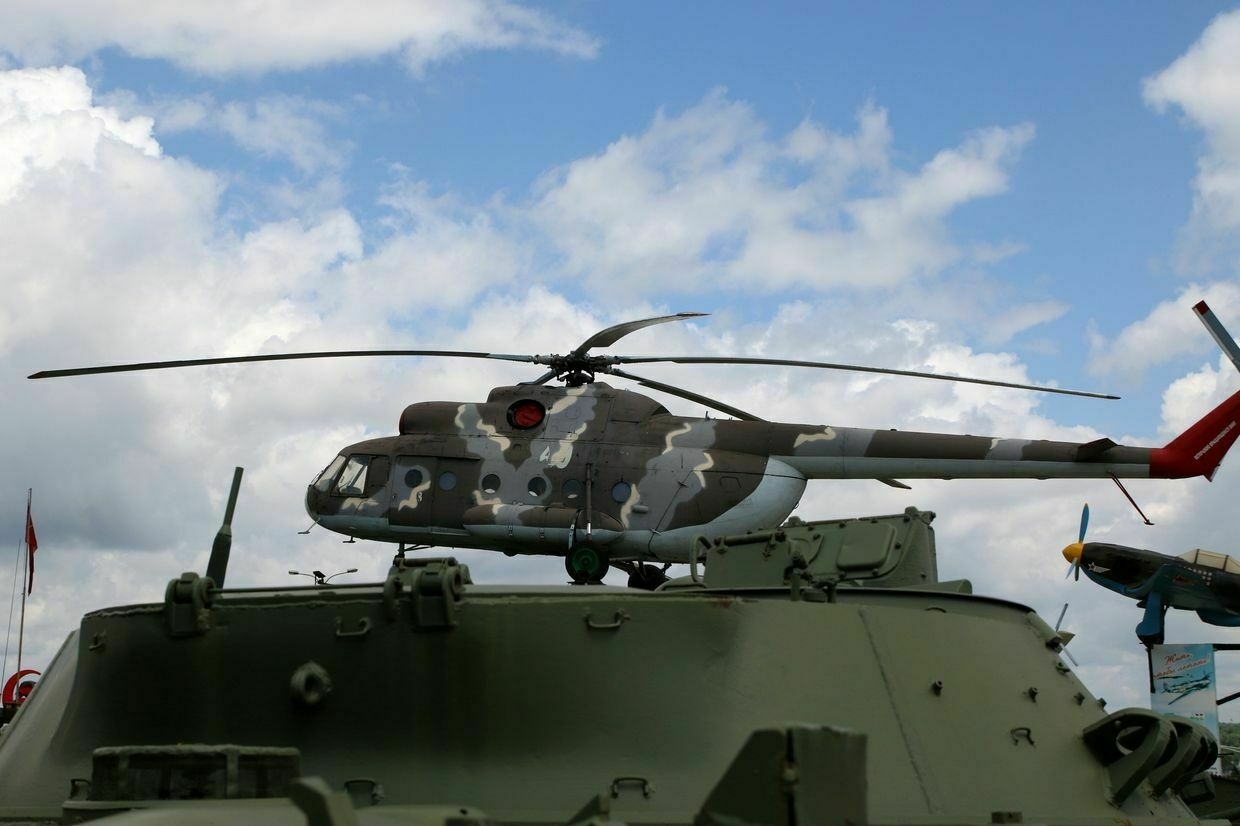
Editor’s note: The previously published footage, provided by an SBU source, was allegedly related to a different operation and was deleted after the mistake was identified.
Drones operated by the Security Service of Ukraine (SBU) struck the Kirovske military airfield in occupied Crimea overnight on June 28, the SBU told the Kyiv Independent.
The attack destroyed Mi-8, Mi-26 and Mi-28 attack helicopters, and a Pantsyr-S1 self-propelled anti-aircraft missile and gun system, the SBU claimed.
According to the SBU, Ukraine targeted Russian aviation, air defense systems, as well as ammunition, reconnaissance and attack drones storage facilities.
Secondary explosions were heard at the airfield during the night.
The Kyiv Independent could not verify these claims.
As Russia intensifies aerial attacks on Ukraine and the civilian death toll climbs, Ukraine has stepped up its drone attacks on Russian territory too.
Earlier on June 27, Ukrainian drones struck four Su-34 fighter jets at the Marinovka airfield in Russia’s Volgograd Oblast, according to the military.
Preliminary reports indicate that two Russian fighter jets were destroyed in the June 27 attack, and the other two were damaged. Russia uses the aircraft to bomb Ukraine.
Since the start of its full-scale war in February 2022, Russia has lost 420 airplanes and 337 helicopters, Ukraine’s General Staff said in its latest update on June 28. The Kyiv Independent could not verify these figures.
Ukraine war latest: Ukrainian drones reportedly strike 4 fighter jets in RussiaKey developments on June 27: * Ukraine war latest: Ukrainian drones reportedly strike 4 fighter jets in Russia * North Korea deployed 20% of Kim’s elite ‘personal reserve’ to fight against Ukraine in Russia, Umerov says * Pro-Palestinian activists reportedly destroy military equipment intended for Ukraine * Zelensky signs decree to synchronize Russia sanctionsThe Kyiv IndependentThe Kyiv Independent news desk
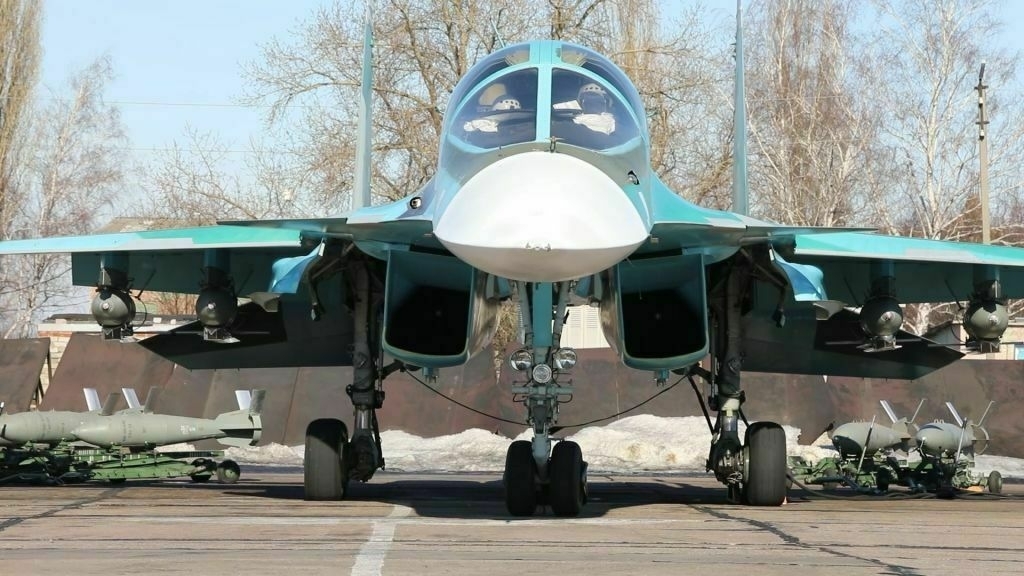
-
Russia revives obsolete T-62 tanks amid equipment shortages, Ukraine's intel claims
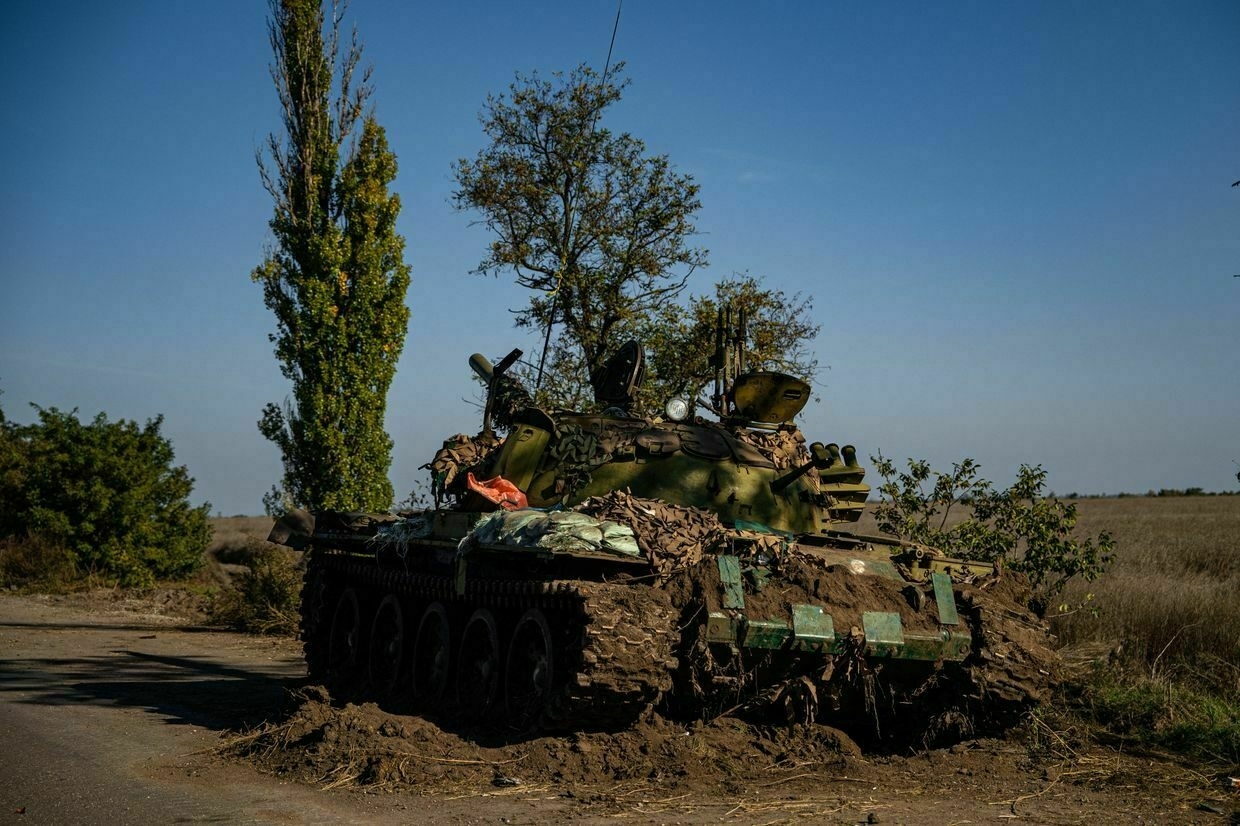
Russia is returning outdated T-62 tanks to service due to mounting equipment losses in its full-scale war against Ukraine and a shortage of modern military equipment, Ukraine’s military intelligence (HUR) said on June 28.
“The key factors limiting the ability to produce modern armored vehicles in Russia are a lack of industrial capacity and a shortage of imported high-tech components,” the agency said.
According to HUR, the restoration of T-62 tanks is primarily carried out at a facility in the village of Atamanovka in Russia’s far-eastern Zabaykalsky Krai.
Russia transferred 21 T-62 tanks from its eastern military district to the European part of the country, the intel claimed.
HUR said that Russia’s stockpile of Soviet-era tanks from the 1970s is being depleted, while most T-62s are even in worse condition after decades of open-air storage without maintenance.
Some of these tanks can also be used at the front as stationary firing points to reinforce defensive positions.
“Due to a severe shortage of modern main battle tanks such as the T-90M and T-72B3M, the deployment of T-62s is seen as a temporary but necessary measure,” the statement read.
Since the start of its full-scale war in February 2022, Russia has lost 10,970 tanks, Ukraine’s General Staff said in its latest update on June 28.
The Kyiv Independent could not verify these numbers.
Ukraine war latest: Ukrainian drones reportedly strike 4 fighter jets in RussiaKey developments on June 27: * Ukraine war latest: Ukrainian drones reportedly strike 4 fighter jets in Russia * North Korea deployed 20% of Kim’s elite ‘personal reserve’ to fight against Ukraine in Russia, Umerov says * Pro-Palestinian activists reportedly destroy military equipment intended for Ukraine * Zelensky signs decree to synchronize Russia sanctionsThe Kyiv IndependentThe Kyiv Independent news desk
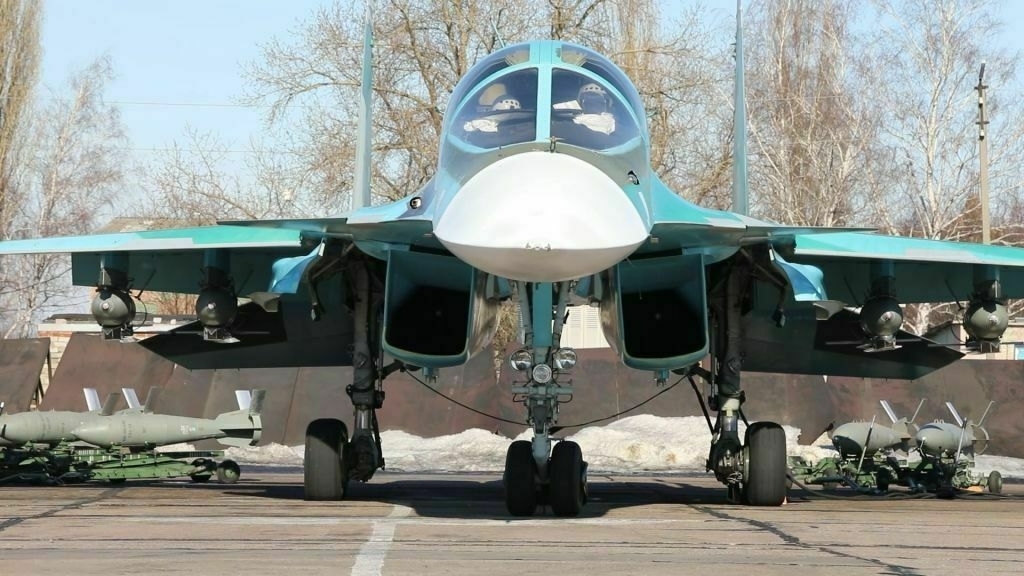
-
Ukraine downs new Russian Grom-1 bomb missile near Dnipro city, official says
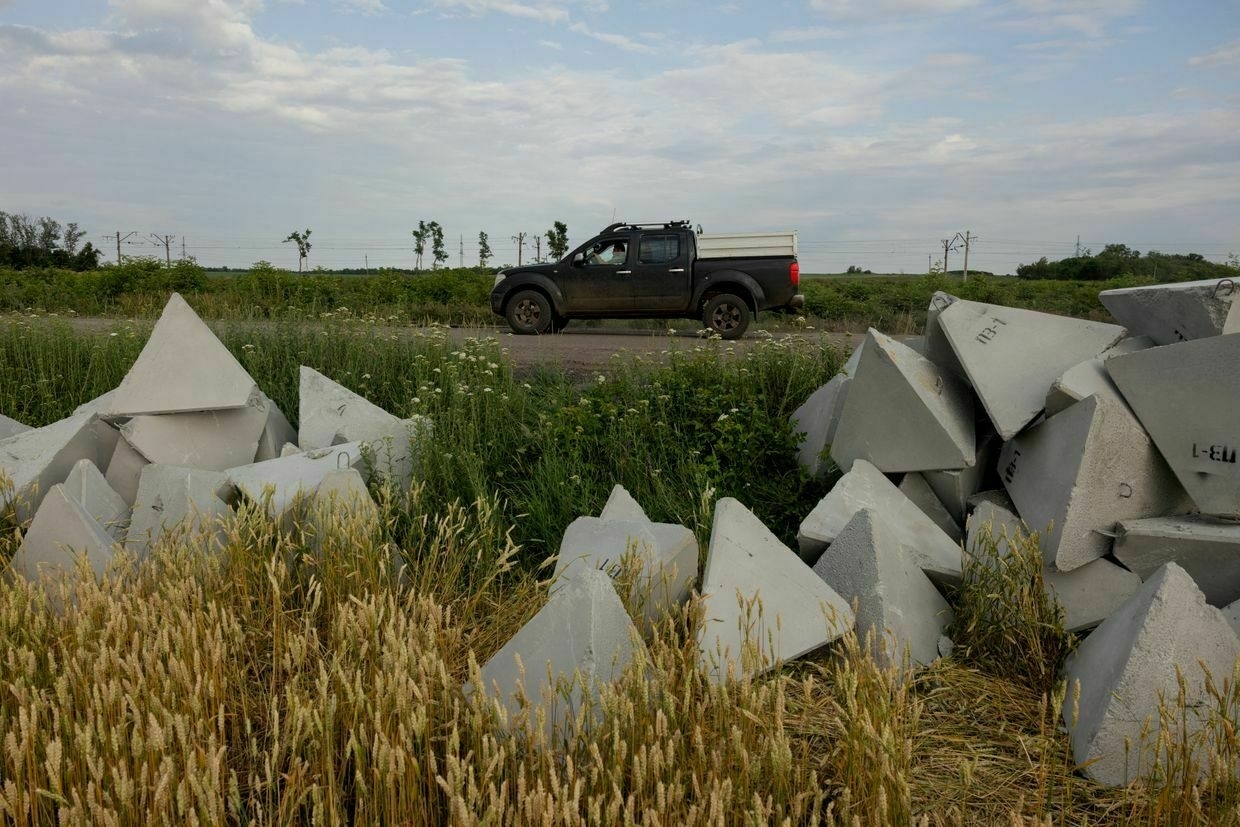
Russia launched its new Grom-1 bomb missile at Dnipropetrovsk Oblast for the first time on June 28, but it was shot down by Ukrainian air defenses, Governor Serhii Lysak said.
The attack comes as Russian troops continue their offensive in neighboring Donetsk Oblast, pushing closer to Dnipropetrovsk Oblast — a major industrial region in central Ukraine.
In mid-June, Ukraine’s military denied reports that Russian troops had entered the region, with President Volodymyr Zelensky saying that Ukrainian troops had intercepted Russian reconnaissance units attempting to breach Dnipropetrovsk Oblast.
Explosions in Dnipro were heard around 11:30 a.m. local time, shortly after the Ukrainian Air Force reported that Russia had launched guided aerial bombs.
The strike was later confirmed to have been launched from the Russian-occupied part of Zaporizhzhia Oblast.
“The target flew more than 100 kilometers and was shot down by air defense outside the city of Dnipro,” the statement read.
Authorities are verifying the wreckage of the downed weapon.
To date, neither Russian guided aerial bombs nor the Grom-1 bomb missile had previously reached the city of Dnipro.
The Grom-1 is described to be a hybrid of a guided aerial bomb and a missile, developed from the Kh-38 missile platform, with an estimated range of up to 120 kilometers.
Russia regularly uses guided aerial bombs to attack front-line areas in Ukraine’s east and south, as well as regional centers such as Kharkiv, Sumy, and Zaporizhzhia.
As Moscow intensifies its attacks on Ukrainian cities, earlier this week on June 24, Russian forces struck civilian infrastructure and a passenger train with ballistic missiles, killing at least 21 people and injuring more than 300 others.
Russia has amassed 111,000 troops near Pokrovsk, Syrskyi saysPokrovsk remains the “hottest spot” along the front line but “the situation is under control” and Russia has not crossed the administrative border from Donetsk to Dnipropetrovsk Oblast, Commander-in-Chief Oleksandr Syrskyi said.The Kyiv IndependentAbbey Fenbert
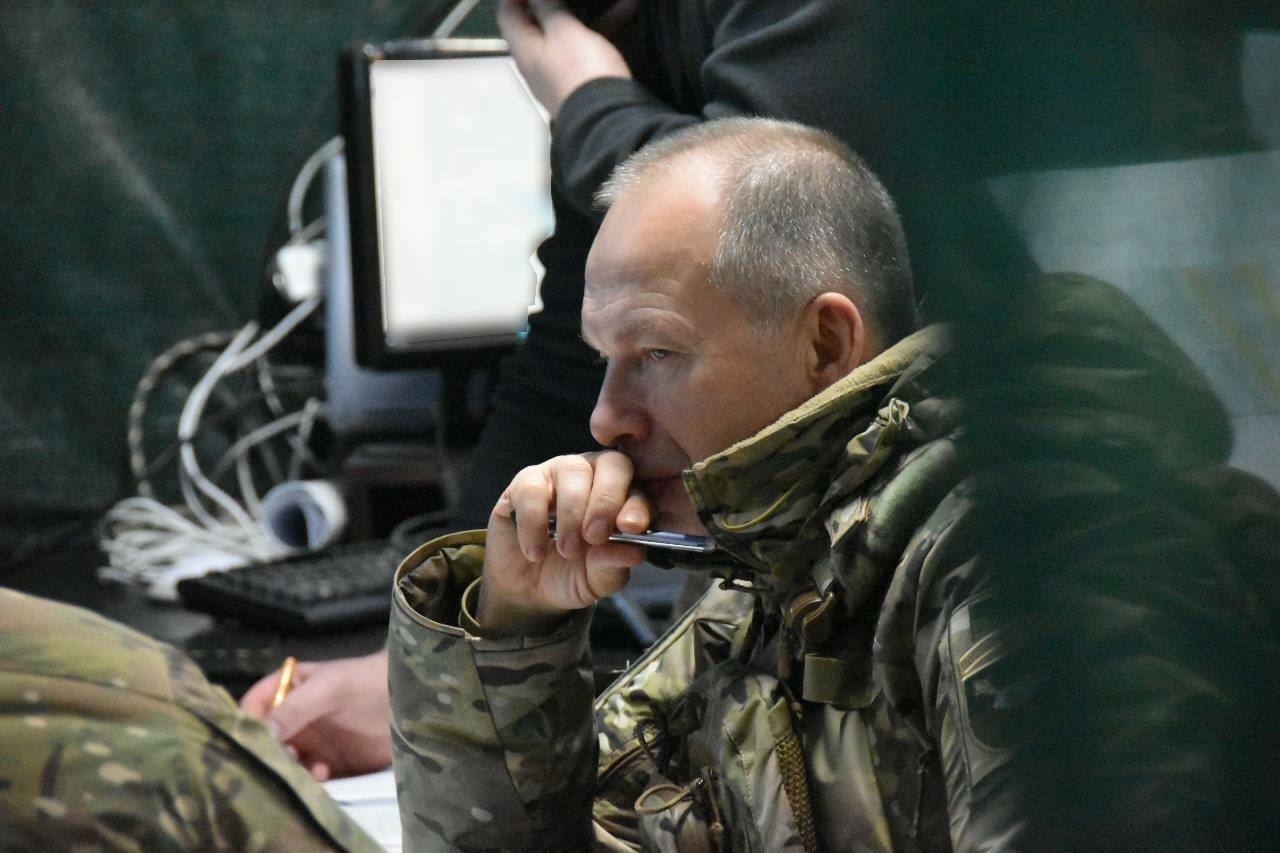
-
Pro-Ukraine partisans disrupt Russian military logistics in occupied Donetsk Oblast, group claims
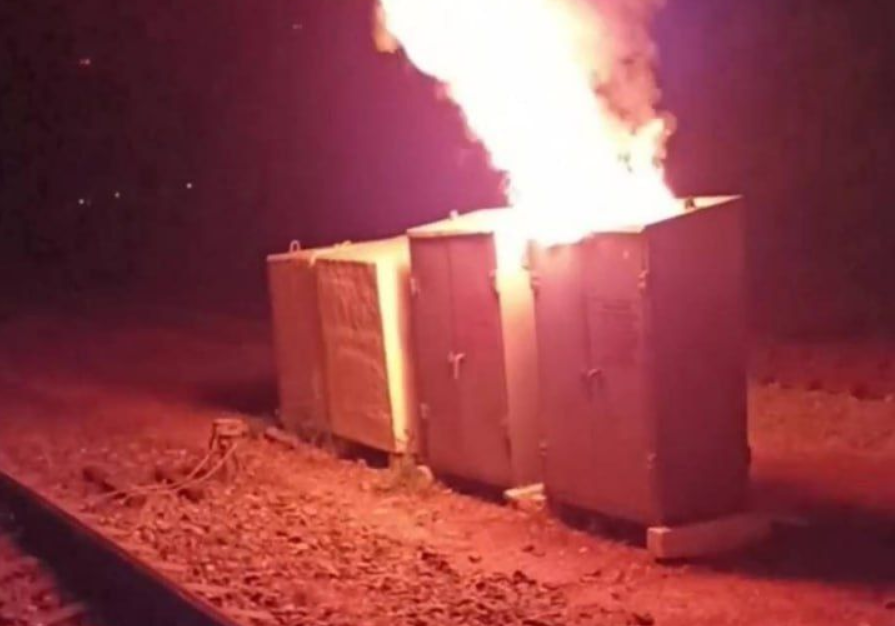
The Atesh partisan group set fire to a signal cabinet that helps control traffic on a railway line near the Russian-occupied city of Yasynuvata in Donetsk Oblast, a route used for Russia’s military logistics, the group claimed on Telegram on June 28.
Yasynuvata lies some 22 kilometers (12.5 miles) from the occupied city of Donetsk and is considered to be a major railway junction in the region.
According to the group, the sabotaged section is located near Russian military units, warehouses, and industrial facilities.
Atesh said the attack disrupted the delivery of a train carrying fuel for Russian forces.
“On Ukraine’s Constitution Day, we remind the occupiers that this is an independent and free country. And Donetsk will always be Ukrainian,” the statement read.
The Kyiv Independent could not verify these claims.
The Atesh partisan group regularly conducts sabotage attacks in Russia and Ukraine’s Russian-occupied territories.
In early June, Atesh claimed to have destroyed a signal cabinet on the new Volnovakha-Mariupol railway, which had been recently built by occupying Russian forces.
Ukraine war latest: Ukrainian drones reportedly strike 4 fighter jets in RussiaKey developments on June 27: * Ukraine war latest: Ukrainian drones reportedly strike 4 fighter jets in Russia * North Korea deployed 20% of Kim’s elite ‘personal reserve’ to fight against Ukraine in Russia, Umerov says * Pro-Palestinian activists reportedly destroy military equipment intended for Ukraine * Zelensky signs decree to synchronize Russia sanctionsThe Kyiv IndependentThe Kyiv Independent news desk
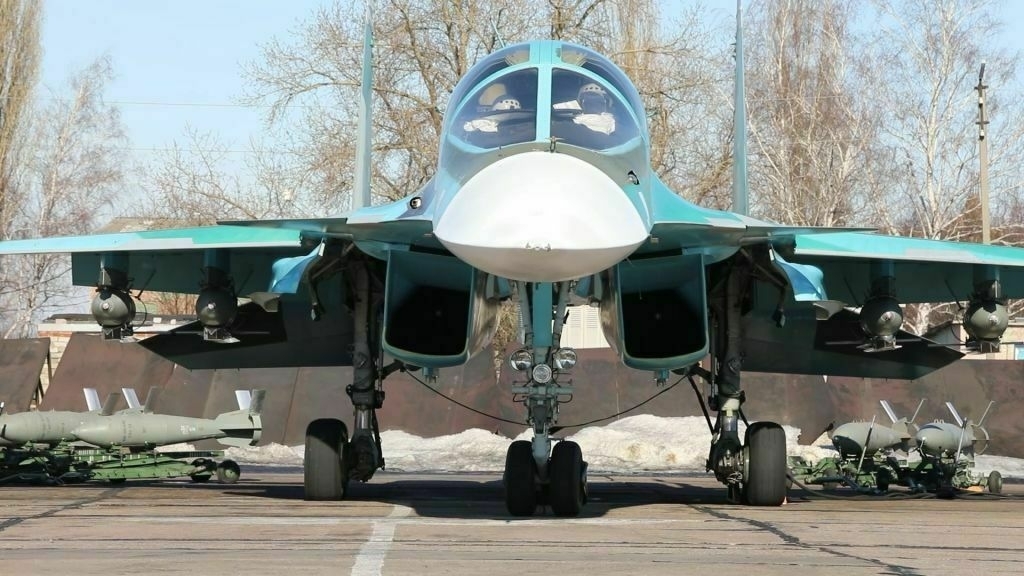
-
Russian attacks against Ukraine kill 10, injure at least 50 over past day
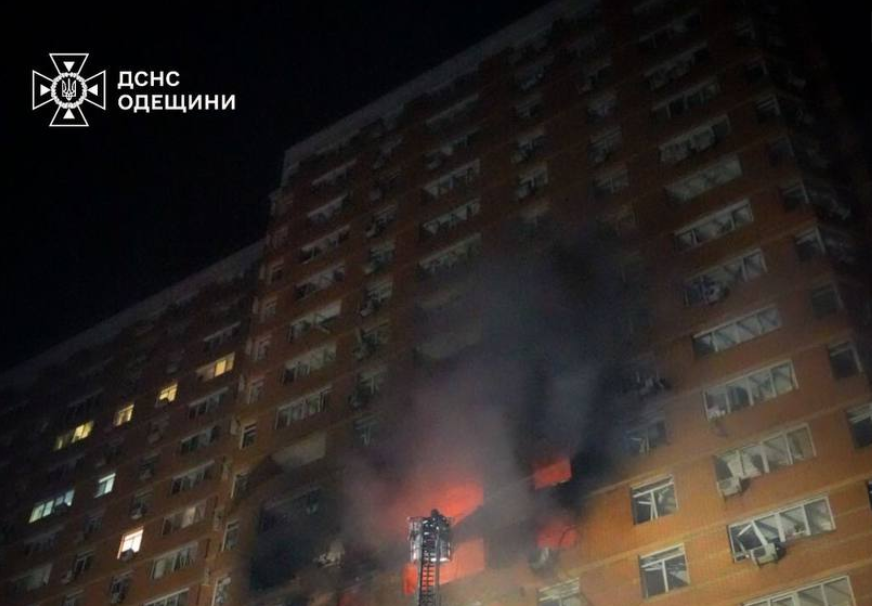
Russian attacks against Ukraine killed 10 people and injured at least 50 others over the past day, regional authorities said on June 28.
Ukrainian forces downed 21 out of the 23 drones, including Shahed-type attack drones and decoys, launched by Russia overnight, the Air Force reported.
One drone was intercepted by electronic warfare or disappeared from radars, according to the statement. Russia usually launches decoys alongside real drones to overwhelm Ukraine’s air defense.
A Russian drone attack on the city of Odesa hit a high-rise building, killing a married couple and injuring at least 14 other people, including three children, Governor Oleh Kiper said.
A Russian missile strike on the city of Samar in Dnipropetrovsk Oblast killed five people and injured at least 25 others, Governor Serhii Lysak said.
Three men aged 30, 36 and 53 were injured in a Russian attack on Chuhuiv in Kharkiv Oblast, according to Governor Oleh Syniehubov.
Russian attacks near Polohy and Vasylivka in Zaporizhzhia Oblast injured a man and a woman, Governor Ivan Fedorov reported.
Russian troops injured a man by dropping an explosive device on the Bilopillia community in Sumy Oblast, local authorities reported.
Two people were killed in Kostiantynivka and Ivanopillia in Donetsk Oblast, Governor Vadym Filashkin said. Two others suffered injuries in the region over the past day.
In Kherson Oblast, Russian forces targeted 42 settlements, including the regional center of Kherson. One person was killed, and three others injured, Governor Oleksandr Prokudin reported.
Russia has amassed 111,000 troops near Pokrovsk, Syrskyi saysPokrovsk remains the “hottest spot” along the front line but “the situation is under control” and Russia has not crossed the administrative border from Donetsk to Dnipropetrovsk Oblast, Commander-in-Chief Oleksandr Syrskyi said.The Kyiv IndependentAbbey Fenbert
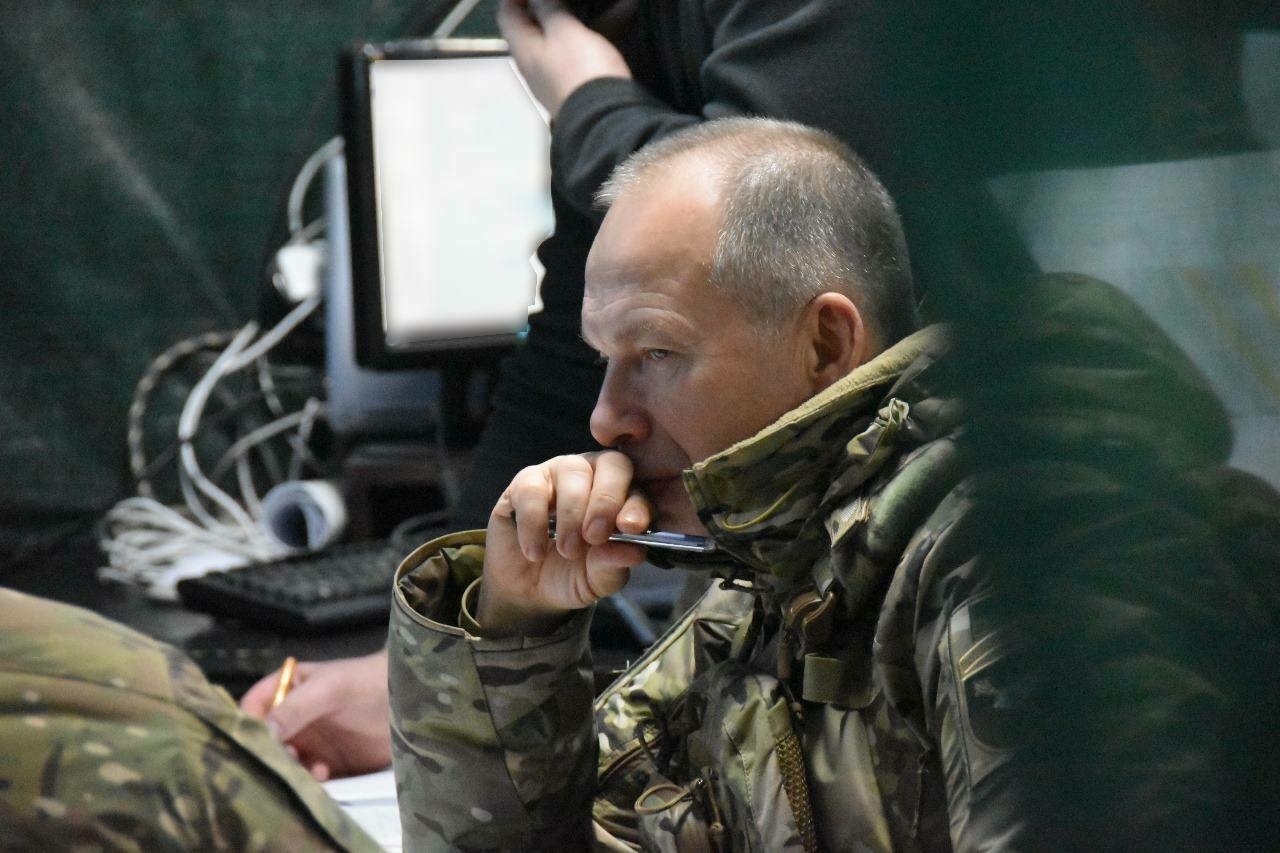
-
Poland's Duda arrives in Kyiv to meet with Zelensky
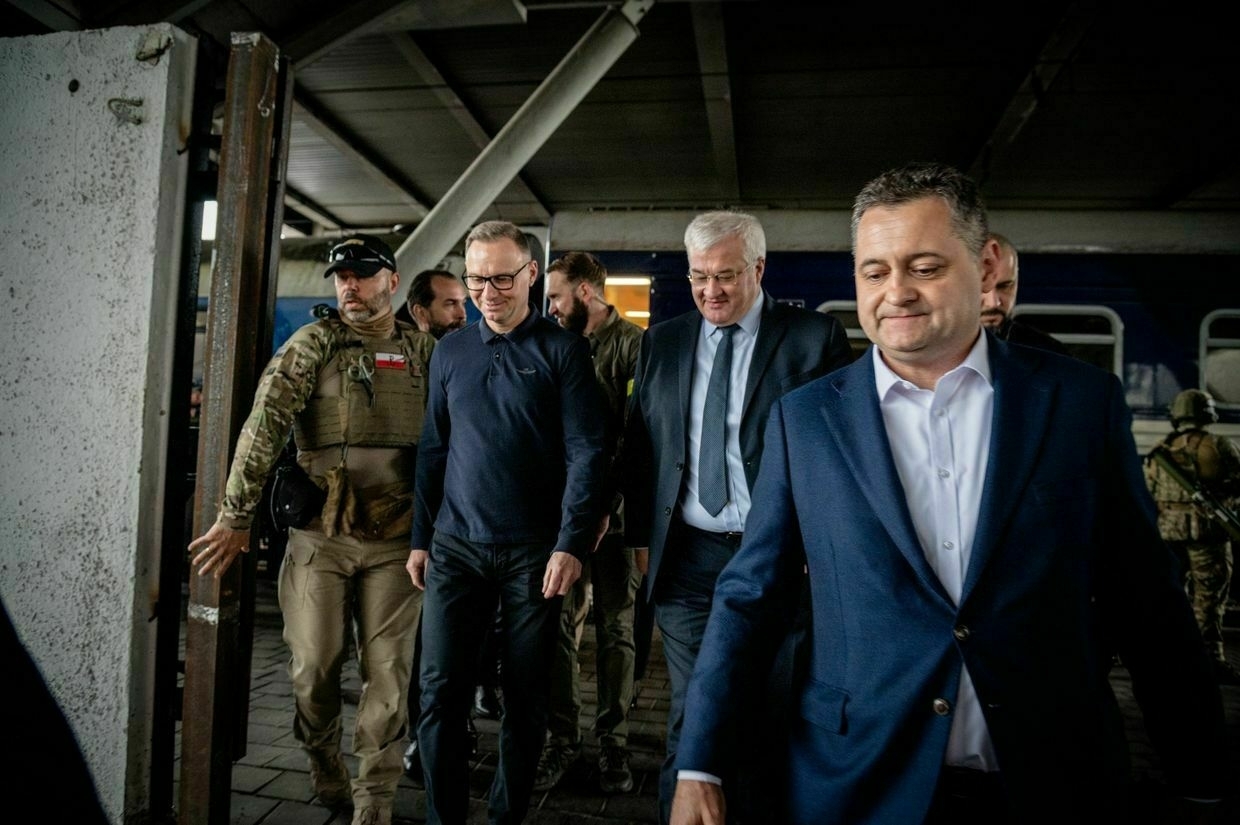
Outgoing Polish President Andrzej Duda arrived in Kyiv to meet with President Volodymyr Zelensky as part of a farewell gesture ahead of his departure from office in August, Duda announced on social media.
“President Duda has stood by Ukraine’s side during the most difficult times of Russia’s full-scale aggression,” Foreign Minister Andrii Sybiha said on X on June 28, which is also Ukraine’s Constitution Day.
“We are grateful to him and all Poles who have shown true solidarity with Ukraine."
Since Russia launched its full-scale invasion in 2022, Poland has emerged as one of Ukraine’s most committed allies, providing weapons, sheltering millions of refugees, and rallying international support.
Over time, the relations between the two countries has faced strains due to political disagreements, economic fatigue, and disputes over grain imports and historical grievances.
In early June, conservative historian Karol Nawrocki won the second round of the Polish presidential election with 50.89% of the vote.
He has previously voiced opposition to Ukraine’s membership in the EU and NATO, despite supporting Ukraine’s sovereignty.
From unity to uncertainty: Central Europe reconsiders its Ukraine stanceIn the fourth year of Russia’s full-scale war against Ukraine, the decisive support Kyiv found among its neighbors to the west is beginning to show cracks. Once resolute Poland is seeing rising skepticism toward Ukraine, underscored by President-elect Karol Nawrocki’s election victory. Slovakia’s pro-Ukrainian government was ousted by Russian-friendly populistsThe Kyiv IndependentMartin Fornusek
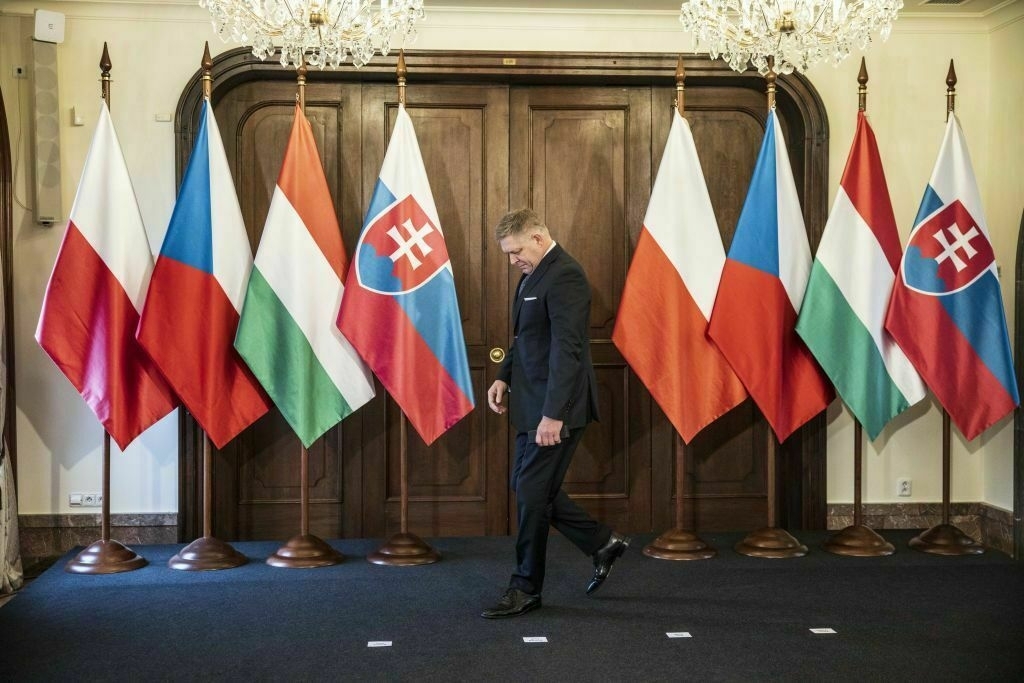
-
General Staff: Russia has lost 1,017,720 troops in Ukraine since Feb. 24, 2022
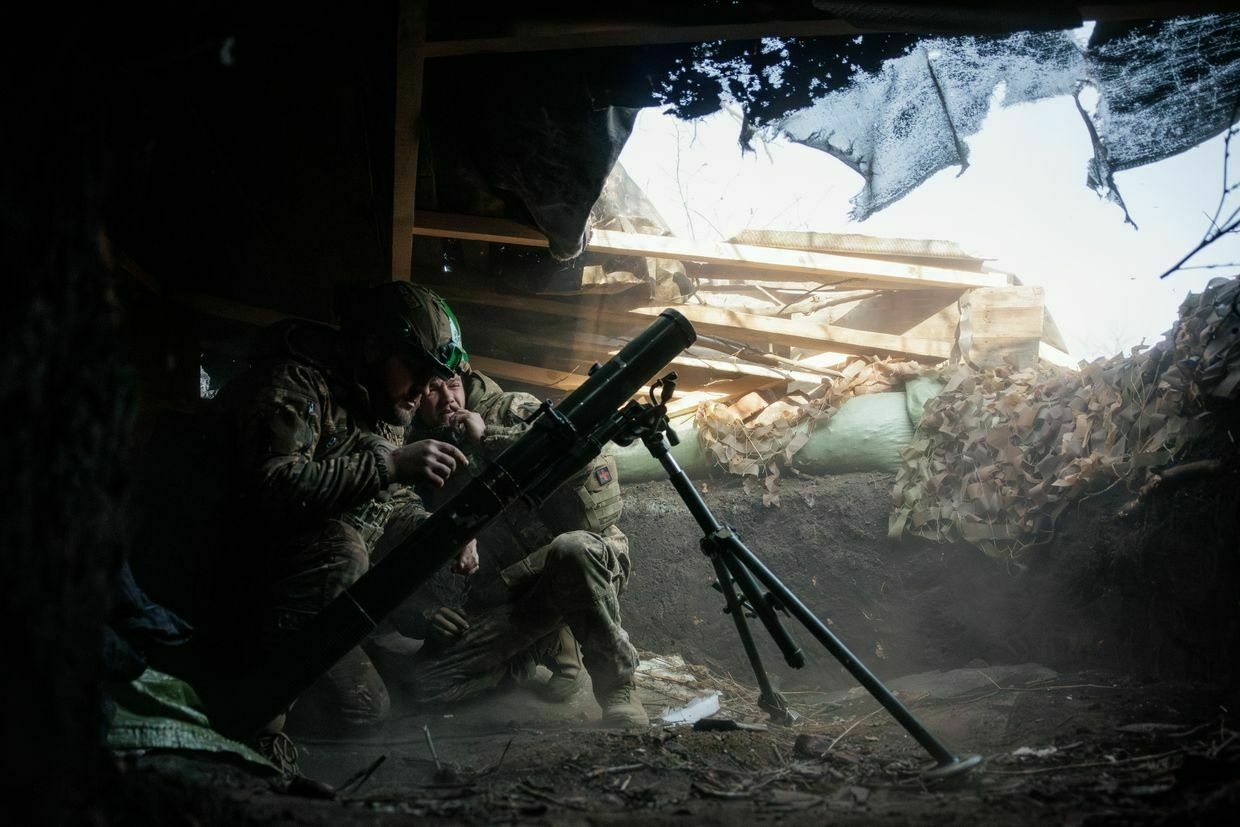
Russia has lost around 1,017,720 troops in Ukraine since the beginning of its full-scale invasion on Feb. 24, 2022, the General Staff of Ukraine’s Armed Forces reported on June 28.
The number includes 1,000 casualties that Russian forces suffered just over the past day.
According to the report, Russia has also lost 10,970 tanks, 22,908 armored fighting vehicles, 53,415 vehicles and fuel tanks, 29,665 artillery systems, 1,425 multiple launch rocket systems, 1,189 air defense systems, 420 airplanes, 337 helicopters, 42,477 drones, 28 ships and boats, and one submarine.
Russia has amassed 111,000 troops near Pokrovsk, Syrskyi saysPokrovsk remains the “hottest spot” along the front line but “the situation is under control” and Russia has not crossed the administrative border from Donetsk to Dnipropetrovsk Oblast, Commander-in-Chief Oleksandr Syrskyi said.The Kyiv IndependentAbbey Fenbert
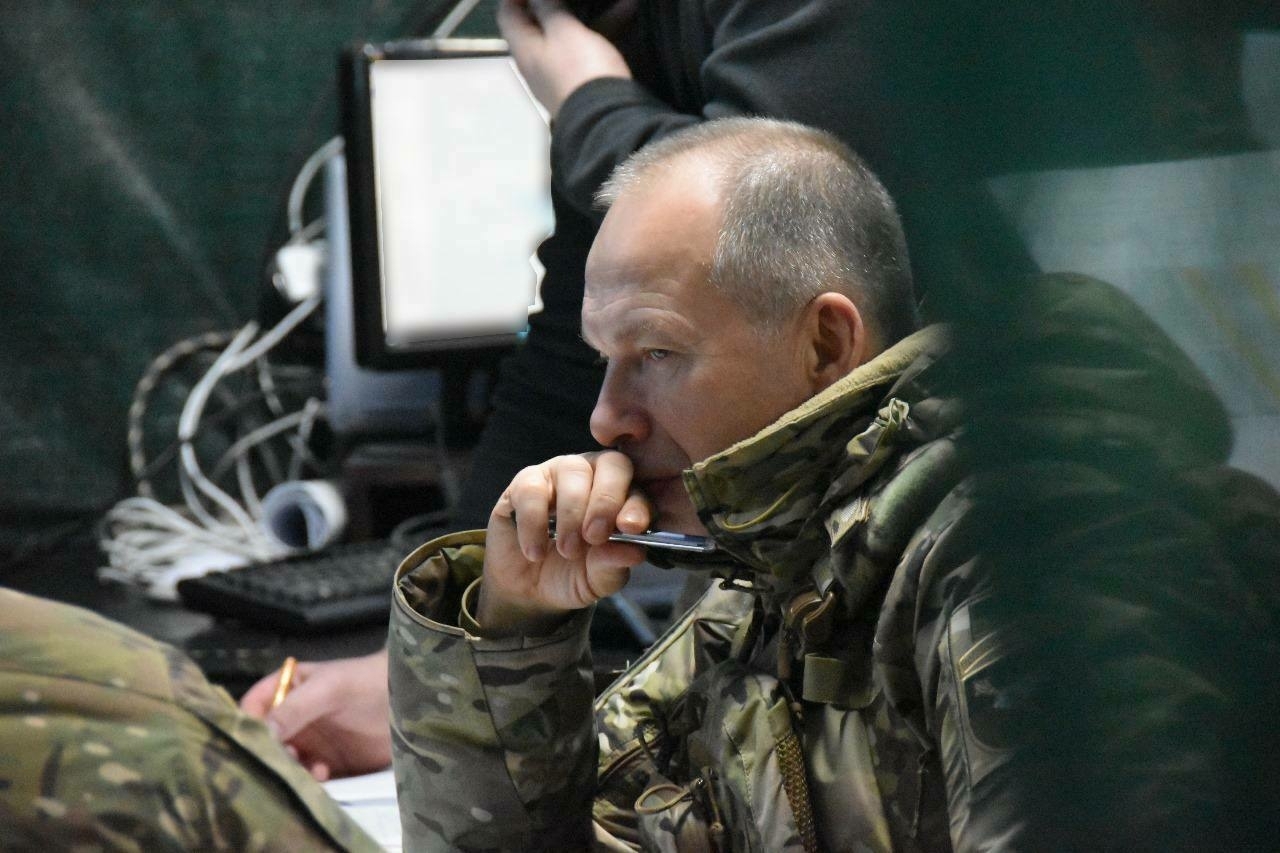
-
Married couple killed in Russian drone strike on Odesa high-rise
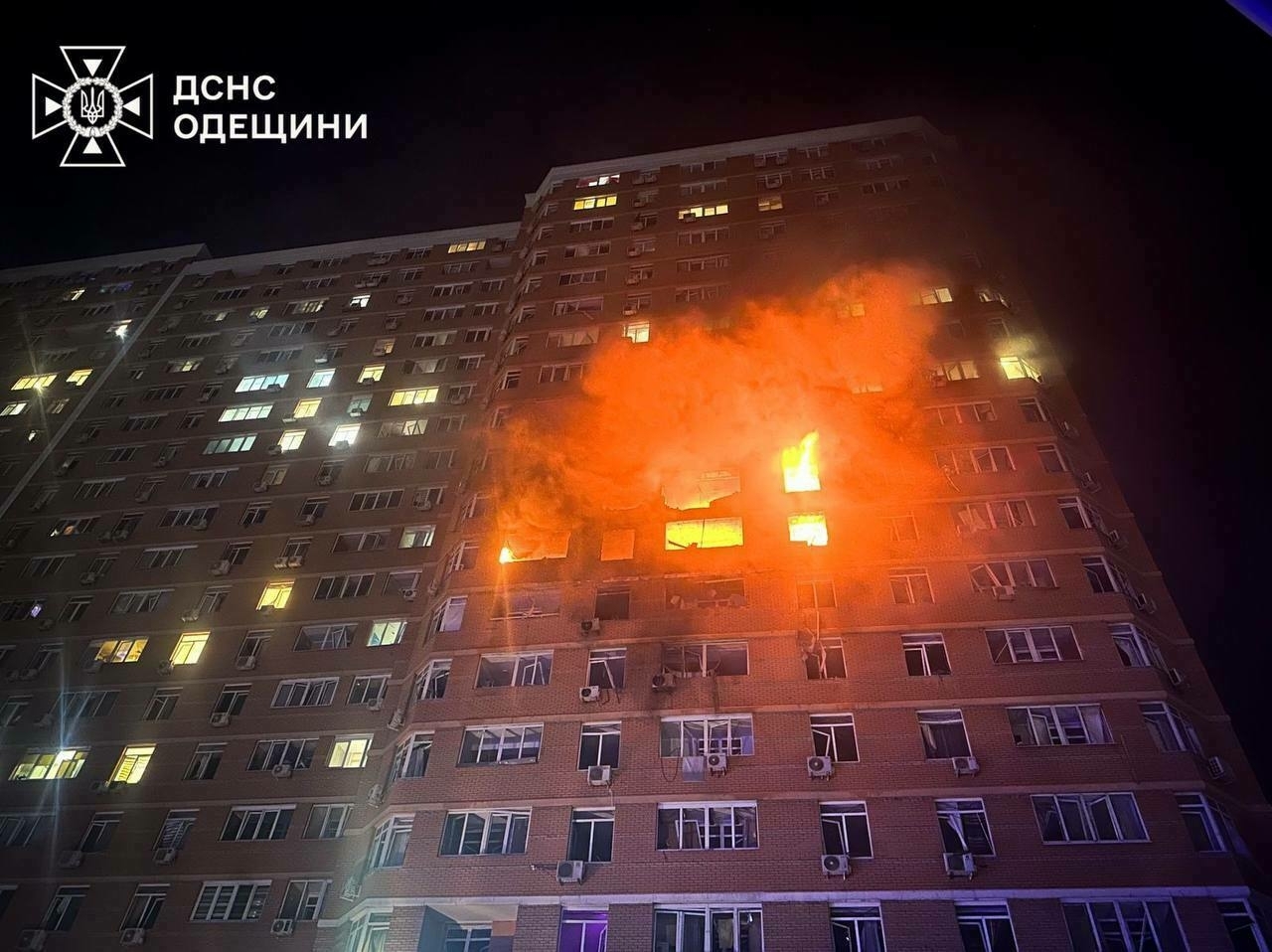
Editor’s Note: This is a developing story.
Russia attacked the southern city of Odesa overnight on June 28, killing two people and injuring at least four others, Ukraine’s State Emergency Service reported.
The drone attack hit a 21-story building, causing a fire on the 7th, 8th, and 9th floors that left residents trapped in their apartments. Emergency responders rescued five people, including a small child.
Two people, a married couple, were killed in the attack, Odesa Oblast Governor Oleh Kiper reported. Emergency workers recovered their bodies from the damaged building.
At least four other civilians were injured. Two of the victims were children, one 7 and the other 3 years old. Both are receiving treatment in medical facilities, Kiper said.
Ongoing air raid alarms throughout the night complicated rescue efforts, the State Emergency Service said.
Odesa, a port city on Ukraine’s Black Sea coast with a population of around 1 million, has been a frequent target of Russian attacks since the full-scale invasion. A massive Russian drone strike on June 20 killed one civilian and injured 14 others, including three first responders.
Russian missile and drone attacks on Ukrainian cities have intensified dramatically in May and June.
Ukraine war latest: Ukrainian drones reportedly strike 4 fighter jets in RussiaKey developments on June 27: * Ukraine war latest: Ukrainian drones reportedly strike 4 fighter jets in Russia * North Korea deployed 20% of Kim’s elite ‘personal reserve’ to fight against Ukraine in Russia, Umerov says * Pro-Palestinian activists reportedly destroy military equipment intended for Ukraine * Zelensky signs decree to synchronize Russia sanctionsThe Kyiv IndependentThe Kyiv Independent news desk
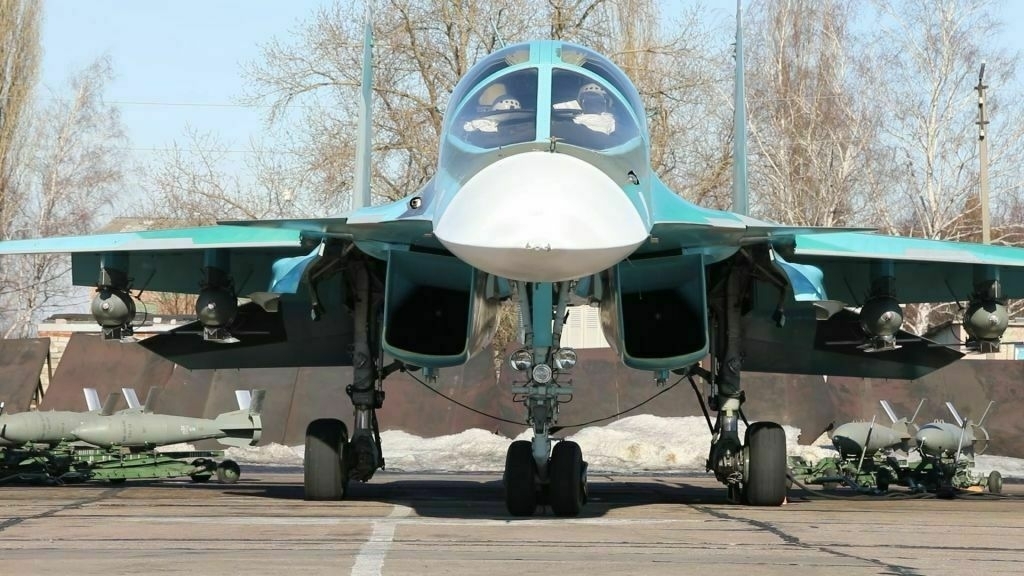
-
Half of Americans support sanctions on countries that buy Russian oil and gas, poll finds
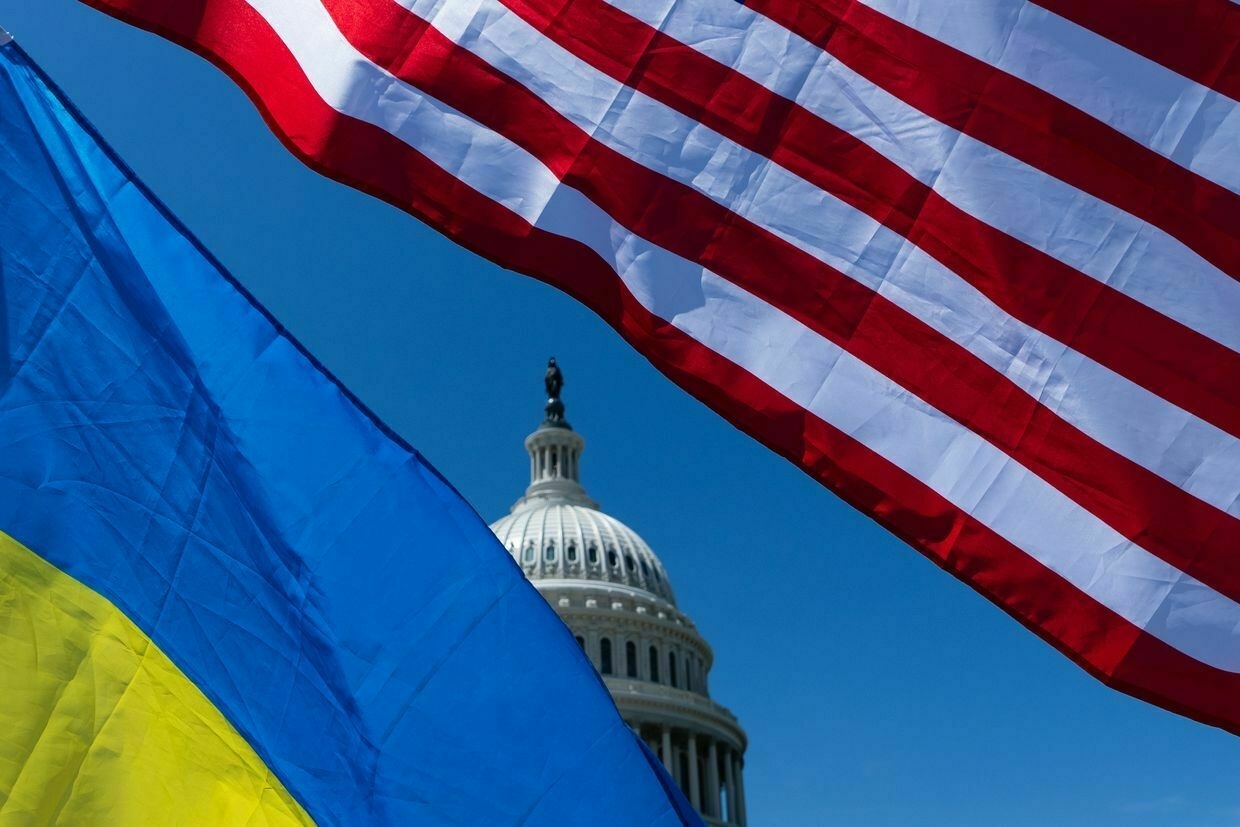
Around 50% of Americans support sanctions against countries that purchase Russian oil and gas, according to the results of a YouGov poll published on June 27.
A bipartisan sanctions bill in the U.S. Senate aims to slap 500% tariffs on imports from countries that continue to purchase Russian energy products. U.S. President Donald Trump has not backed the measure and a vote on the bill has reportedly been postponed.
In a YouGov survey of adult U.S. citizens conducted June 12-16, 24% said they “strongly support” sanctioning Russian energy buyers while 25% said they “somewhat support” secondary sanctions against these countries.
Like the Senate bill, support for secondary sanctions among respondents was bipartisan. Of “strong supporters,” 26% indentified as Democrats while 27% were Republicans.
More Republicans than Democrats said they favored the specific 500% tariff penalty proposed by legislators. While 29% of respondents who “strongly supported” the measure were Democrats, 41% were Republicans. Only 32% of survey respondents overall said they supported the 500% tariff.
The 500% tariff has been championed by Republican Senator Lindsey Graham, a Trump ally and co-author of the sanctions bill alongside Democrat Richard Blumenthal. Along with tariffs on countries purchasing Russian oil, the bill would also slap “bone-crushing” new sanctions against Russia, according to Graham.
A majority of Americans support increasing or maintaining U.S. sanctions against Russia, the survey found. Here the division along party lines is stark, with 59% of those in favor of increasing sanctions on Moscow identifying as Democrats and only 37% identifying as Republicans.
The poll also showed that about 50% of Americans oppose cutting military aid to Ukraine. According to YouGov, 26% of U.S. adults are in favor of increasing military aid while 23% believe Washington should maintain its current levels of support.
The results illustrate the contrast between the prevailing views of the American public and the policies of the Trump administration. Trump has repeatedly undercut the Senate sanctions bill, requesting delays to the vote and calling on lawmakers to weaken the proposed measures.
While Trump has at times threatened to impose new sanctions on Russia, he has never followed through on any of those threats and consistently shoots down domestic and international appeals to get tough on Moscow. At the recent G7 Summit in Canada, Trump reportedly insisted that sanctions would be at odds with U.S. business interests.
U.S. Defense Secretary Pete Hegseth also announced earlier this month that Washington will cut military aid to Ukraine in its upcoming defense budget.
‘Putin cannot stop’ – Estonian foreign minister says war in Ukraine existential for Russian presidentAs Russia continues to intensify its onslaught on Ukraine more than three years into the full-scale invasion, Kyiv faces a new challenge – keeping its Western allies, namely the new U.S. administration, engaged in the struggle. This became clear during the NATO summit in The Hague on June 24-25, whereThe Kyiv IndependentMartin Fornusek
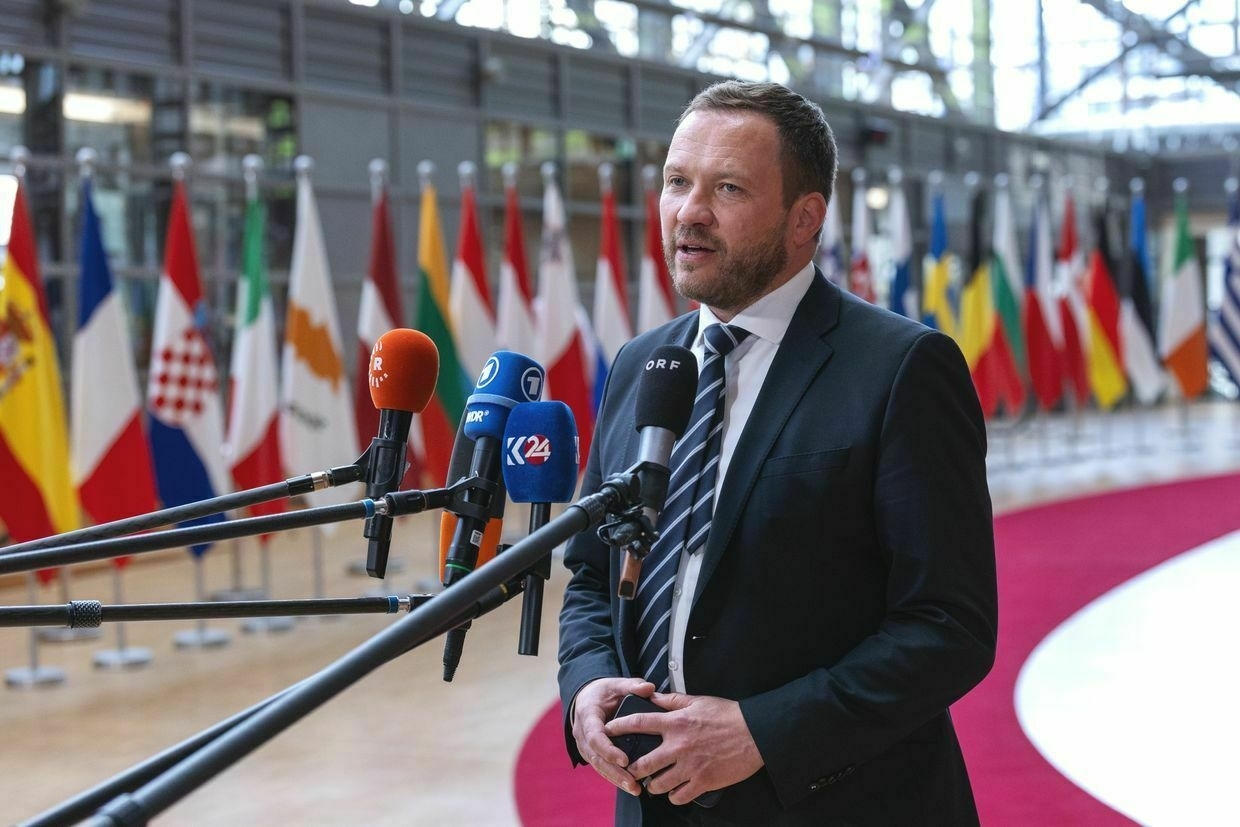
-
Ukrainian weapons account for more than 40% of arms used in defense against Russia, Zelensky says
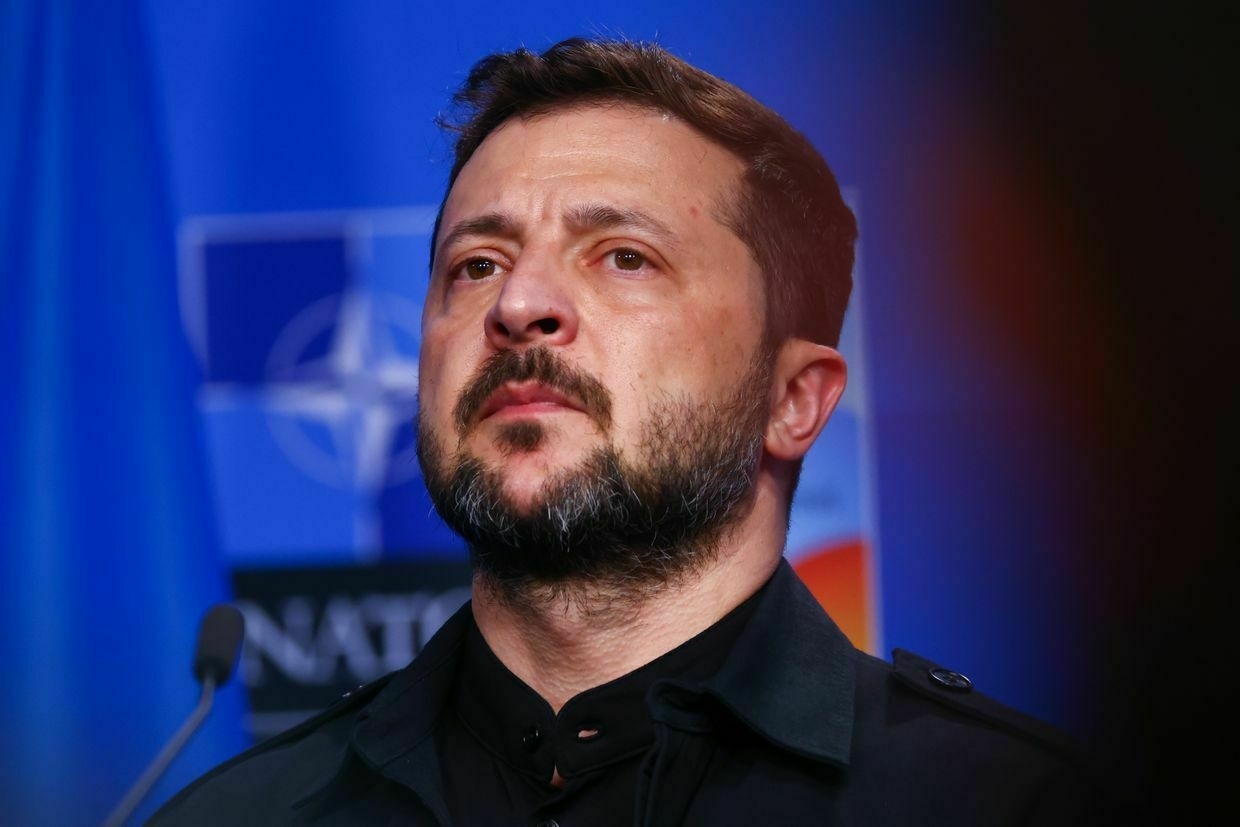
Ukraine provides over 40% of the weapons used to defend the nation’s independence against Russia’s full-scale invasion, President Volodymyr Zelensky said at the State and Business Forum in Kyiv on June 27.
As Ukraine scales up domestic defense production, Zelensky has been lobbying foreign partners to provide funding to help match its manufacturing capacity.
The government and Ukrainian businesses now provide more than 40% of the weapons the country uses in its fight against Russia, Zelensky said. Business-driven innovations in technology have helped Ukraine on the battlefield, particularly in drone development.
“Thanks to Ukrainian entrepreneurship and all the conditions we have created as a state, a new sector of our domestic manufacturing has emerged and immediately become one of the world’s most advanced — the production of drones of various types,” Zelensky said.
“Hundreds of companies are now involved in weapons production in one way or another.”
Zelensky’s comments come a day after Defense Minister Rustem Umerov reported that Ukrainian companies have increased their industrial capacity in order to produce four million drones a year.
At the NATO summit in The Hague on June 24, Zelensky said Ukraine could potentially produce as many as eight million drones per year, but lacks the financial backing to achieve its full capacity. During the summit, Ukraine signed agreements on joint weapons production with the U.K. and Denmark in an effort to bridge the gap between Kyiv’s capacity and current funds.
Ukraine has rapidly developed its drone capabilities since 2022, evolving from modifying commercial aircraft to producing military UAVs, attack drones, and reconnaissance systems at scale.
Operation Spiderweb, a mass attack on four key military airfields in Russia, was carried out entirely with Ukrainian drones.
Ukraine war latest: Ukrainian drones reportedly strike 4 fighter jets in RussiaKey developments on June 27: * Ukraine war latest: Ukrainian drones reportedly strike 4 fighter jets in Russia * North Korea deployed 20% of Kim’s elite ‘personal reserve’ to fight against Ukraine in Russia, Umerov says * Pro-Palestinian activists reportedly destroy military equipment intended for Ukraine * Zelensky signs decree to synchronize Russia sanctionsThe Kyiv IndependentThe Kyiv Independent news desk
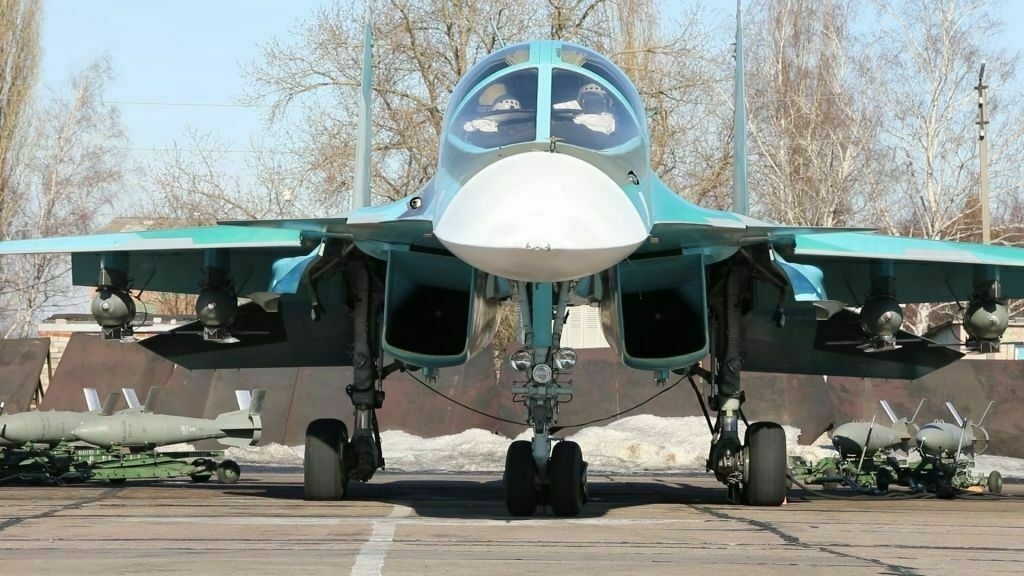
-
Zelensky to impose long-term moratorium on business inspections in Ukraine
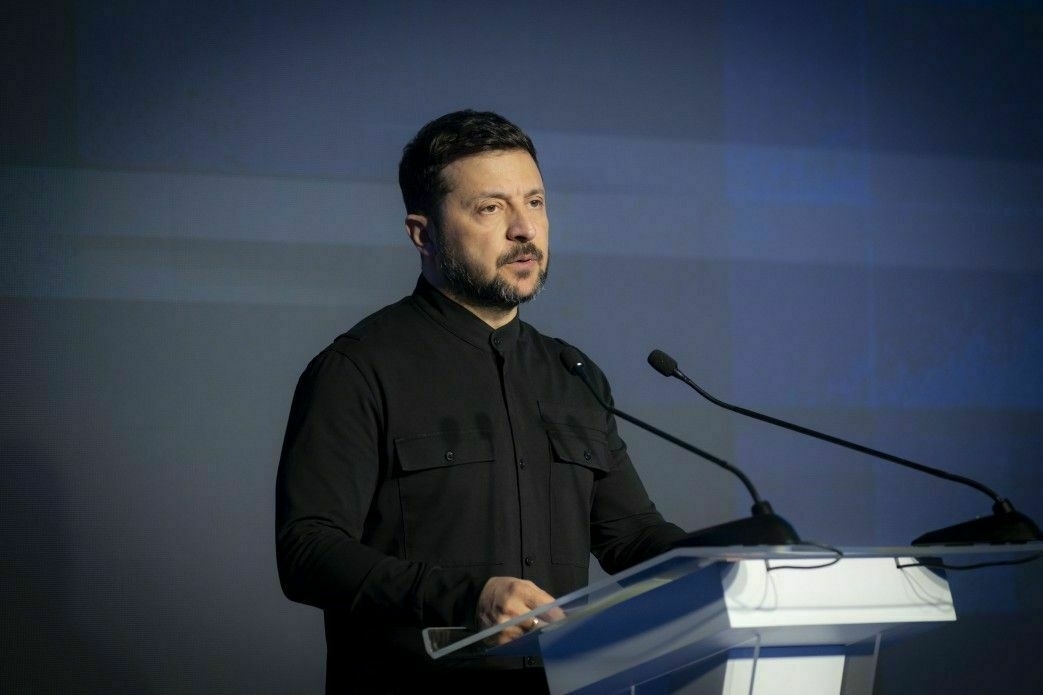
President Volodymyr Zelensky has instructed government officials to prepare a decision introducing a long-term moratorium on business inspections in Ukraine, the Presidential Office announced on June 27.
Zelensky discussed the moratorium during an address at the “State and Business Forum: From Dialogue to Partnership,” held in Kyiv.
“I have instructed that a decision on a long-term moratorium on business inspections be prepared to protect businesses from any pressure by unscrupulous individuals in various government positions,” he said.
Economic growth is a vital component of Ukrainian resilience, necessitating ongoing dialogue between the government and entrepreneurs, Zelensky said. In addition to imposing the moratorium on inspections, Kyiv will also expand the Council for Entrepreneurship Support in an effort to cultivate entrepreneurship in Ukraine.
“Even under such harsh conditions of this war, Ukraine can rely on its entrepreneurs — on our domestic Ukrainian manufacturing, our Ukrainian logistics, our Ukrainian services across all sectors — from security to everyday life, as well as on Ukrainian developments and investments,” the president said.
Following Russia’s full-scale invasion in early 2022 and the onset of martial law, Ukraine temporarily suspended certain business regulations, including tax inspections for businesses. Zelensky signed a law resuming tax inspections for certain businesses in December 2023.
Now in its fourth year of full-scale war against Russia, Ukraine’s economy is still attempting to recover from the massive blow dealt in 2022, when the GDP dropped by 29.1%. At the same forum on June 27, Ukraine’s new Prosecutor General Ruslan Kravchenko announced another measure meant to boost business: an audit of criminal cases related to businesses in Ukraine.
“The second priority is to finally sort out the proceedings related to business, protect business, and achieve justice in these matters,” Kravchenko said.
The Prosecutor’s Office will be dedicated to “ensuring the rights of investors and businesses,” Kravchenko wrote on his Telegram channel on June 26. Efforts to safeguard businesses will not interfere with Ukraine’s legal obligations and the regulatory reforms required for its integration into the European Union, he said.
Ukraine’s new top prosecutor known for high-profile cases, seen as Zelensky loyalistLoyalty to the incumbent administration has been the key requirement for prosecutor generals in Ukraine. Ruslan Kravchenko, who was appointed as prosecutor general on June 21, appears to be no exception. Previously he had been appointed as a military governor by President Volodymyr Zelensky and is seen as a presidential loyalist. Kravchenko became Ukraine’s top prosecutor after a lengthy hiatus during which the position of prosecutor general remained vacant. His predecessor, Andriy Kostin, r The Kyiv IndependentOleg Sukhov
The Kyiv IndependentOleg Sukhov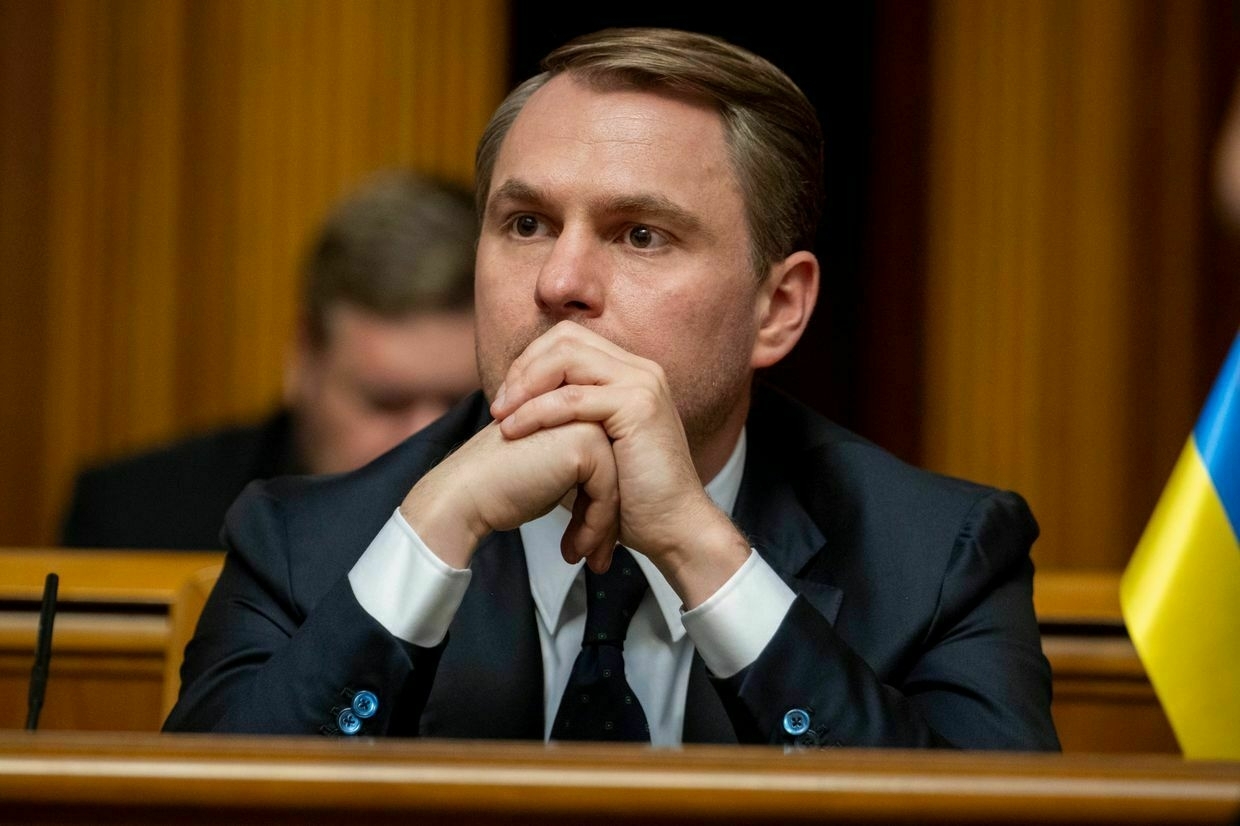
-
Russia has amassed 111,000 troops near Pokrovsk, Syrskyi says
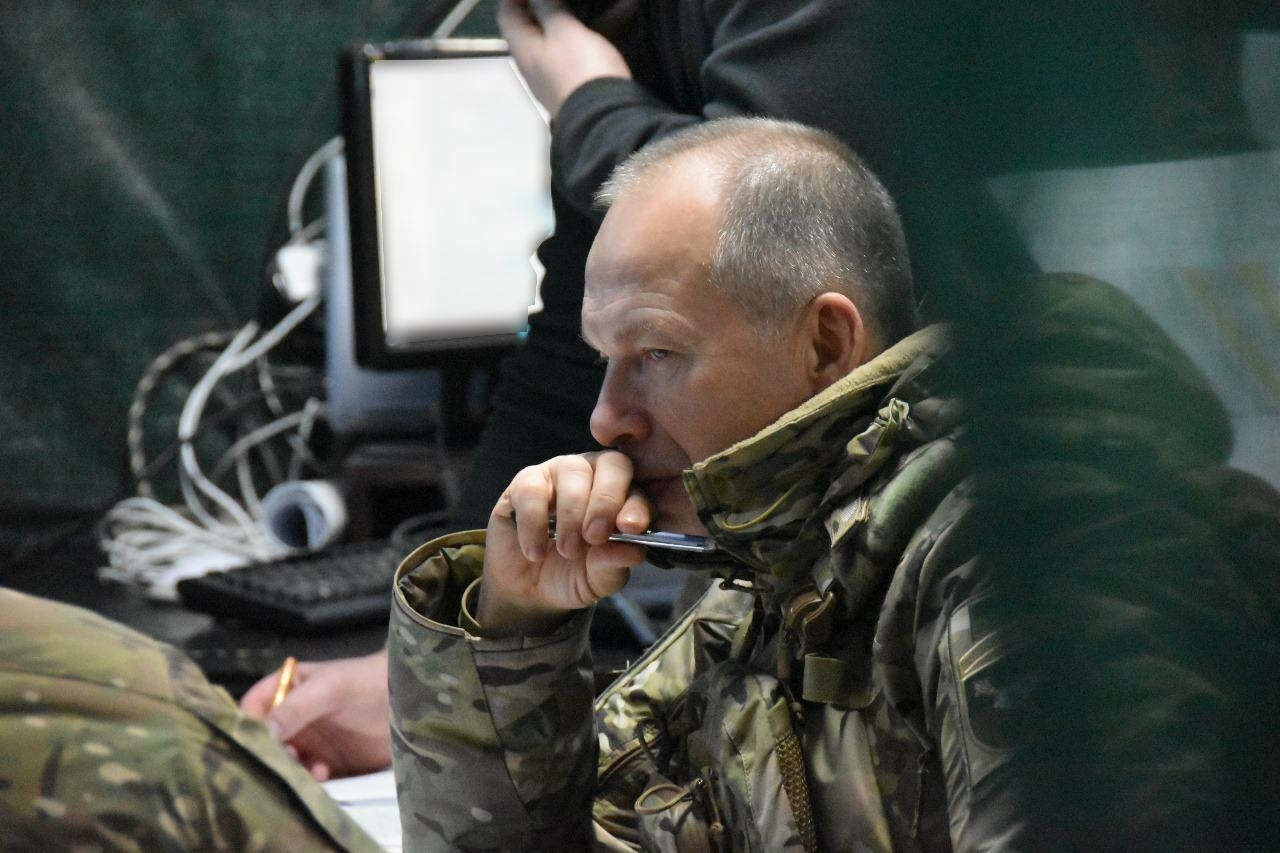
Pokrovsk remains the “hottest spot” along Ukraine’s front lines, with Russia concentrating its largest group of personnel in that direction — a force numbering 111,000 troops, Commander-in-Chief Oleksandr Syrskyi reported on June 27.
Russia has for months focused its offensive efforts on the embattled town of Pokrovsk in Donetsk Oblast and has recently been escalating attempts to break through to neighboring Dnipropetrovsk Oblast, a region that has not yet seen combat. Ukraine denied reports that Russian forces breached the regional border in May and June.
In May, Syrskyi reported that Ukraine had stabilized the situation in Pokrovsk.
After a working visit to the Pokrovsk sector, Syrskyi on June 27 said that the city is still “the hottest spot along the entire 1,200-kilometer front line” with nearly 50 combat clashes recorded per day. It’s also where Russia has concentrated the bulk of its forces in Ukraine.
Russia has amassed “about 111,000 personnel” in the Pokrovsk sector, Syrskyi said, but Ukrainian forces are holding the line.
“The enemy continues to try to break through to the administrative border of Donetsk Oblast … Russian sabotage and assault groups were particularly active here two weeks ago,” Syrskyi said.
“But they were all destroyed or neutralized, and the remnants were pushed back from the administrative border. The situation is under control."
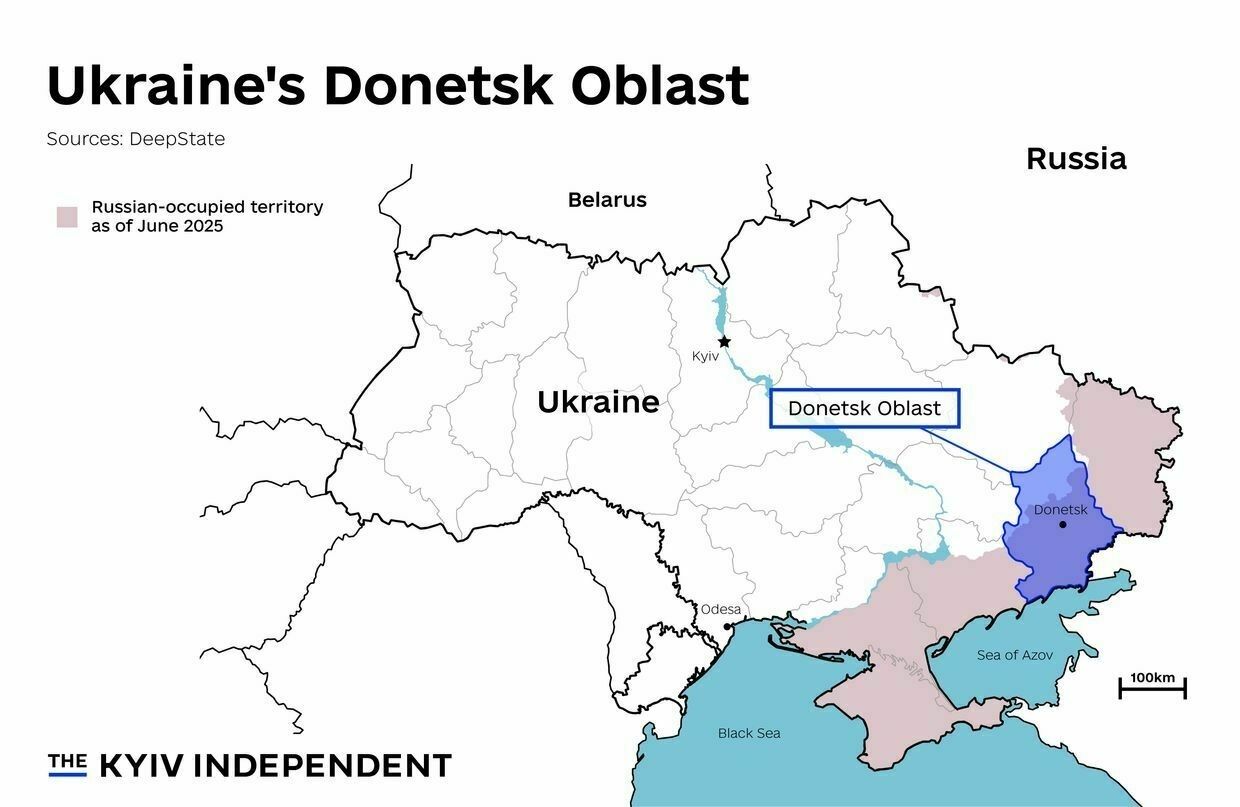
Ukraine’s Donetsk Oblast (Nizar al-Rifai/The Kyiv Independent) Russia is attempting to break into Dnipropetrovsk Oblast not only for operational reasons, but also for performative ones, Syrskyi said.
“To achieve a psychological effect: to put the infamous ‘foot of the Russian soldier’ there, plant a flag, and trumpet another pseudo-‘victory.'"
Syrskyi’s comments echo recent remarks by Russian President Vladimir Putin, who claimed in a propaganda-heavy speech on June 20 that “wherever the foot of a Russian soldier steps is Russian land.” President Volodymyr Zelensky fired back the next day, promising “Ukrainian drones for the foot of every Russian soldier.”
While Putin claimed on June 27 that Moscow is “ready” for a third round of peace talks with Kyiv, the Kremlin has sent no signal that it’s ready to abandon its maximalist ambitions in Ukraine.
Russia’s so-called “peace memorandum” demands that Ukraine recognize Russia’s annexation of Crimea, as well as Kherson, Donetsk, Zaporizhzhia, and Luhansk oblasts — none of which are fully under Moscow’s control.
Zelensky’s Deputy Chief of Staff Pavlo Palisa said on June 6 that Russia aims to occupy all Ukrainian territory east of the Dnipro River and advance toward Odesa and Mykolaiv in a broader plan to sever Ukraine’s access to the Black Sea amid a renewed summer offensive.
Ukraine war latest: Ukrainian drones reportedly strike 4 fighter jets in RussiaKey developments on June 27: * Ukraine war latest: Ukrainian drones reportedly strike 4 fighter jets in Russia * North Korea deployed 20% of Kim’s elite ‘personal reserve’ to fight against Ukraine in Russia, Umerov says * Pro-Palestinian activists reportedly destroy military equipment intended for Ukraine * Zelensky signs decree to synchronize Russia sanctionsThe Kyiv IndependentThe Kyiv Independent news desk
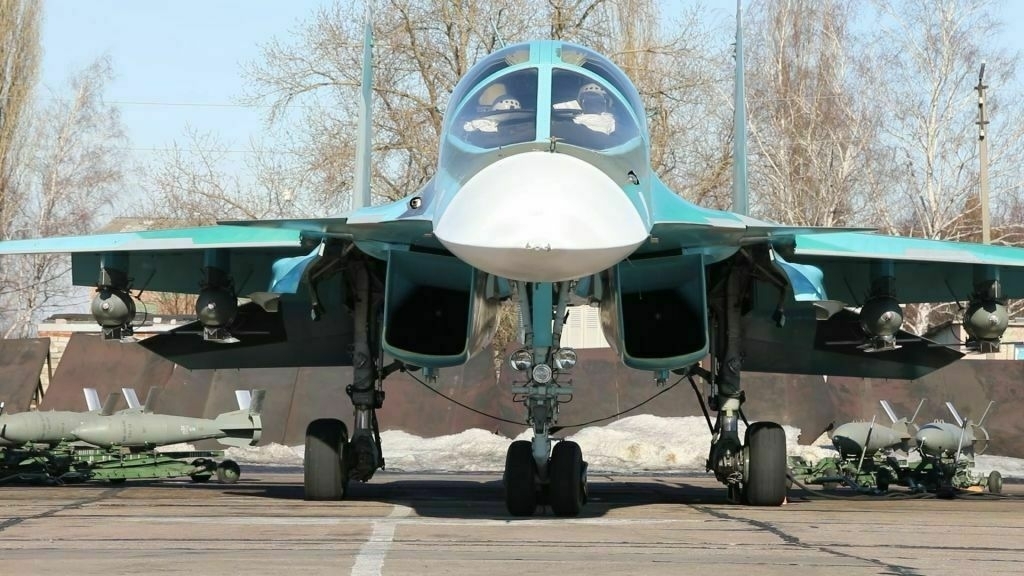
-
Ukraine imposes new sanctions on Russian individuals, Chinese company involved in Shahed drone production
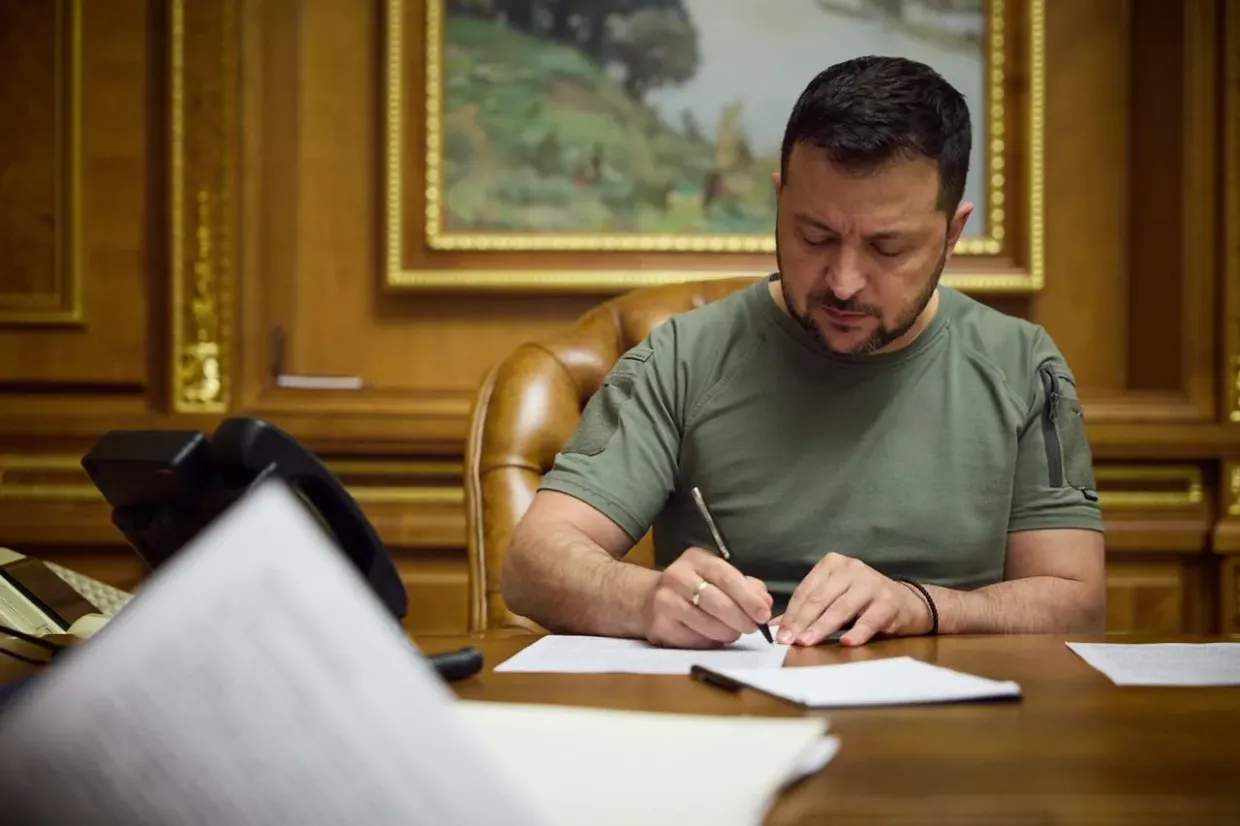
President Volodymyr Zelensky signed a decree on June 27 imposing sanctions on 52 Russian citizens as well as an additional 34 Russian companies and one Chinese entity involved in the production of Shahed-type drones and chip manufacturing machinery.
Ukraine introduced new restrictions as Russia has escalated drone attacks against Ukrainian cities over the past weeks, launching upwards of 400-500 unmanned aerial vehicles (UAVs) per night.
Individuals and legal entities subject to Ukrainian sanctions cannot do business and trade in Ukraine, cannot withdraw their capital from the country. In the meantime, their assets are blocked, as well as their access to public and defense procurement, and entry into the territory of Ukraine, among other restrictions.
Andrii Yermak, head of the Presidential Office, said on Telegram that the sanction primarily enterprises and individuals collaborating with a Shahed manufacturing facility located in the town of Yelbuga in Russia’s Tatarstan.
Russia has launched thousands of cheap but effective Iranian-designed Shahed drones against Ukraine since the fall of 2022. Originally designed in Iran, Russia has since produced its own Shahed-type drones on Russian territory.
Drones have become one of the defining tools of the full-scale war, used extensively by both Ukraine and Russia for surveillance, long-range strikes, and tactical battlefield advantage.
Earlier in the day, Zelensky signed a decree to coordinate sanctions against Russia with international partners, particularly the European Union and the Group of Seven (G7).
EU reportedly fails to adopt new Russia sanctions due to Hungarian, Slovak oppositionUnlike Ukraine-skeptic Hungarian Prime Minister Viktor Orban, Slovakia has not previously attempted to block EU sanctions. The Kyiv IndependentKateryna Hodunova
The Kyiv IndependentKateryna Hodunova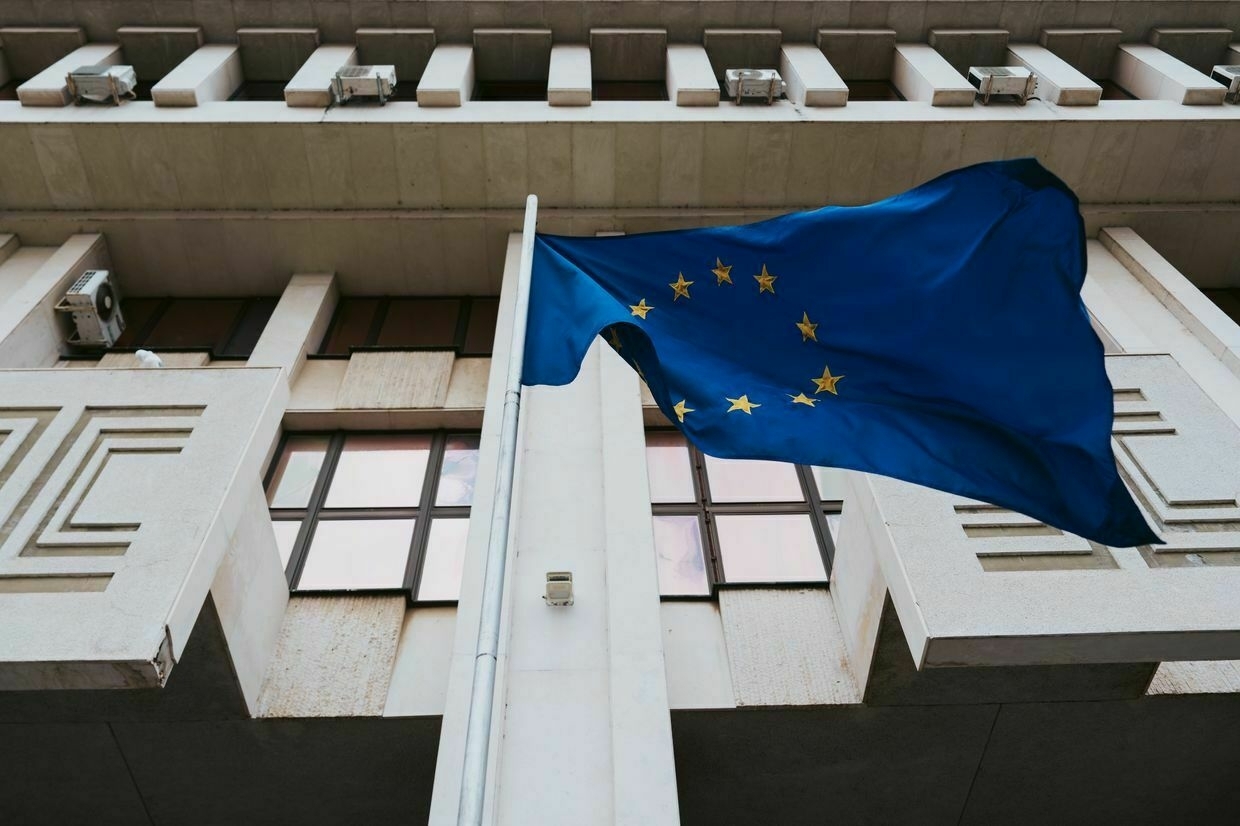
-
Despite escalating war plans, Putin claims Russia will cut military spending starting in 2026
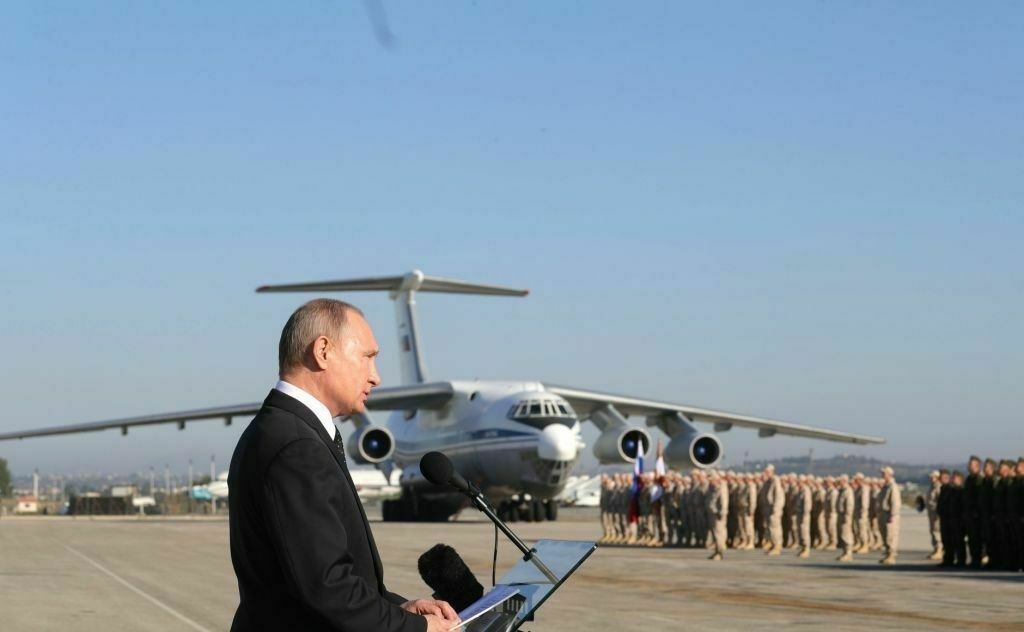
Russian President Vladimir Putin claimed on June 27 that Moscow plans to cut its military expenditure beginning next year, in a rebuke of NATO members' plans to increase defense spending to 5% of GDP.
Putin’s claims will likely be met with harsh skepticism from Western officials as Russia’s military spending has continued to increase throughout its ongoing invasion of Ukraine.
The Kyiv Independent cannot verify claims made by Putin. The Russian president did not provide any specifics as to how Moscow plans to cut military spending, but added there has yet to be an agreement between ministries.
“We are planning to reduce defence spending. For us, next year and the year after, over the next three-year period, we are planning for this,” Putin told reporters during a visit to Belarus. “Europe is thinking about how to increase its spending, on the contrary. So who is preparing for some kind of aggressive actions? Us or them?” Putin continued.
Putin’s comments comes as NATO allies are increasingly concerned about Russia’s military capabilities, including future threats to alliance members as well as ongoing sabotage efforts.
On June 25, NATO member states agreed to a new defense spending benchmark, committing to allocate 5% of their GDP annually to defense and security-related expenditures by 2035.
The decision comes as NATO allies increasingly believe Russia could rebuild sufficient military capacity to challenge the alliance within five years, with NATO Secretary General Mark Rutte warning that allies must act urgently to prepare for future threats.
“We see Russia’s deadly terror from the skies over Ukraine every day. We must be able to defend ourselves from such attacks,” Rutte said during a press briefing on June 23. “Our security environment has changed, and not for the better. The threats we face today demand that we do far more,” he added.
Various European intelligence agencies as well as officials have increasingly delivered dire warnings about the threat emanating from Russia and Europe’s current lack of preparedness. German intelligence chief Bruno Kahl told a parliamentary hearing in October that Russia will have the military capabilities to be able to attack NATO by 2030.
In 2024, Russia’s military spending surpassed the combined defense budgets of all European nations. Russia’s total defense expenditures surged by 42% in real terms amounting to $462 billion, according to the data by the International Institute for Strategic Studies (IISS).
By comparison, total defense spending across Europe, including the U.K. and EU member states, increased by nearly 12% last year to $457 billion, slightly trailing Moscow’s budget.
The Moscow Times reported in December that the Kremlin had spent an unprecedented $43 billion in the third quarter of 2024 alone.
‘Putin cannot stop’ – Estonian foreign minister says war in Ukraine existential for Russian presidentAs Russia continues to intensify its onslaught on Ukraine more than three years into the full-scale invasion, Kyiv faces a new challenge – keeping its Western allies, namely the new U.S. administration, engaged in the struggle. This became clear during the NATO summit in The Hague on June 24-25, whereThe Kyiv IndependentMartin Fornusek
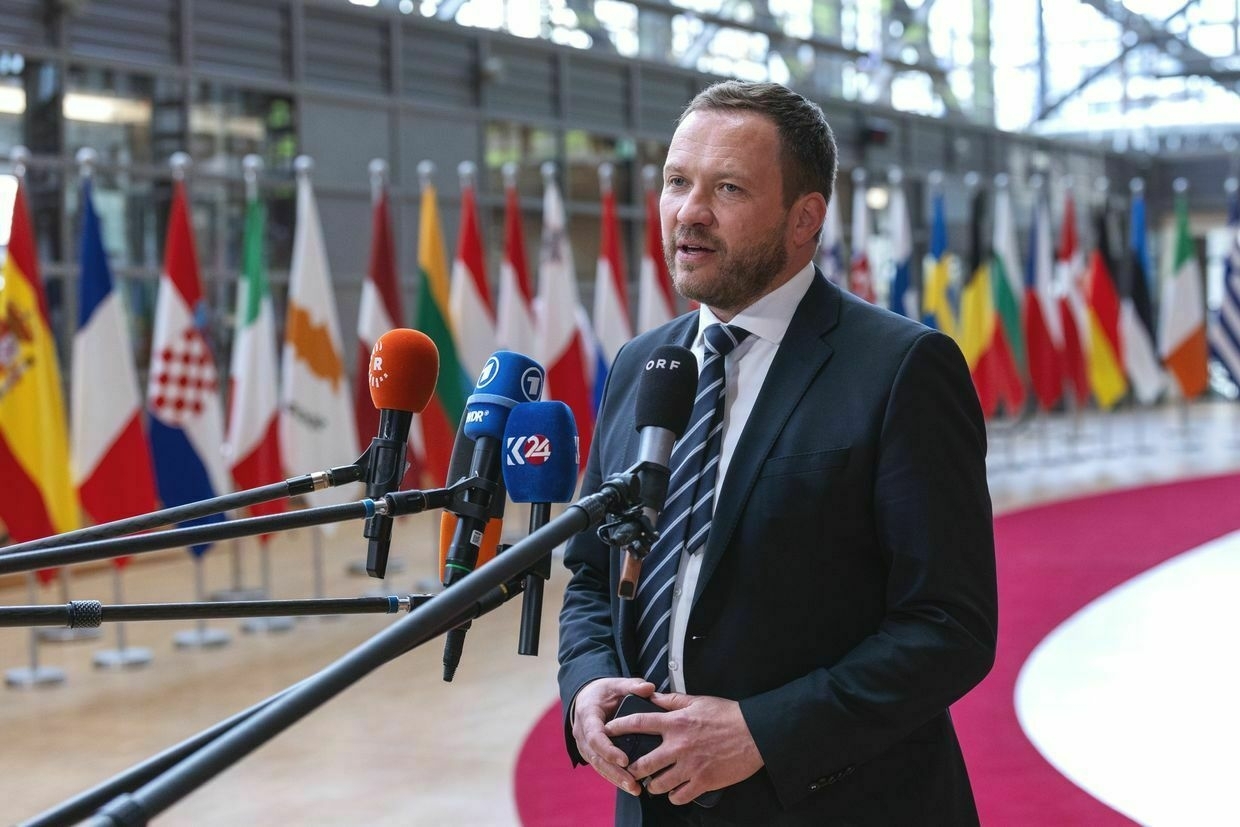
-
'Without question' — Trump says US would consider bombing Iran again, halts plans to ease sanctions
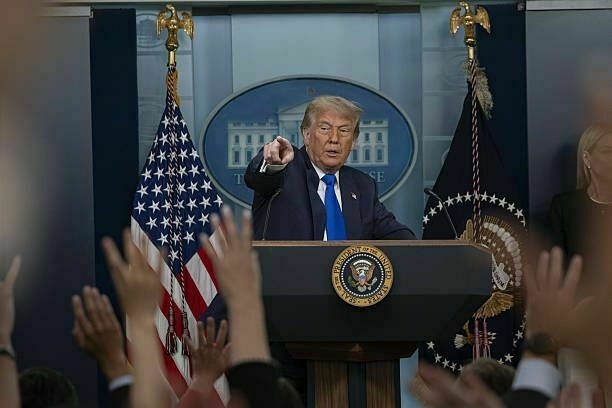
The United States would consider bombing Iran again if the country’s nuclear program once again became of concern, U.S. President Donald Trump told reporters during a press briefing on June 27.
When asked whether Trump would consider bombing Iran if the country were able to enrich uranium to a concerning level, Trump responded: “Sure. Without question, absolutely."
On June 21, the United States conducted strikes on three major Iranian nuclear sites, Fordow, Natanz, and Isfahan, dropping over a dozen bunker buster bombs on the sites and causing significant damage to the country’s nuclear program.
“Turned out to be unbelievable,” Trump said of the strikes on June 27, despite mixed reports on the success of the strikes.
A leaked U.S. Defense Intelligence Agency (DIA) assessment, reported by CNN, found that the strikes did not destroy the core of Tehran’s nuclear program. Instead, the intelligence suggests the attacks likely delayed Iran’s progress by “a few months."
Despite the leak, Trump administration officials have rebuffed reports that the strikes did not fully fulfill its object, amid reports of Iran having possibly moved its enriched uranium away from the sites.
“The objective was to eliminate enrichment in Iran… and he achieved that objective,” U.S. Special Envoy to the Middle East Steve Witkoff said on June 24, adding that he personally reviewed damage assessments and saw “no doubt” that key nuclear infrastructure was destroyed.
Trump’s comments on future attacks comes as Iran’s Supreme Leader Ayatollah Ali Khamenei downplayed the success of the strikes, claiming victory over Israel and the United States.
“I SAVED (Khamenei) FROM A VERY UGLY AND IGNOMINIOUS DEATH,” Trump wrote on Truth social on June 27, adding that he has halted plans to potentially ease sanctions on Iran. “The sanction are BITING,” Trump wrote.
“Iran has to get back into the World Order flow, or things will only get worse for them,” he added.
On June 24, Trump announced that a ceasefire between Iran and Israel had come into effect, following the U.S. strikes on Iranian nuclear facilities and a retaliatory Iranian attack on a U.S. military base in Qatar.
Ukraine war latest: Ukrainian drones reportedly strike 4 fighter jets in RussiaKey developments on June 27: * Ukraine war latest: Ukrainian drones reportedly strike 4 fighter jets in Russia * North Korea deployed 20% of Kim’s elite ‘personal reserve’ to fight against Ukraine in Russia, Umerov says * Pro-Palestinian activists reportedly destroy military equipment intended for Ukraine * Zelensky signs decree to synchronize Russia sanctionsThe Kyiv IndependentThe Kyiv Independent news desk
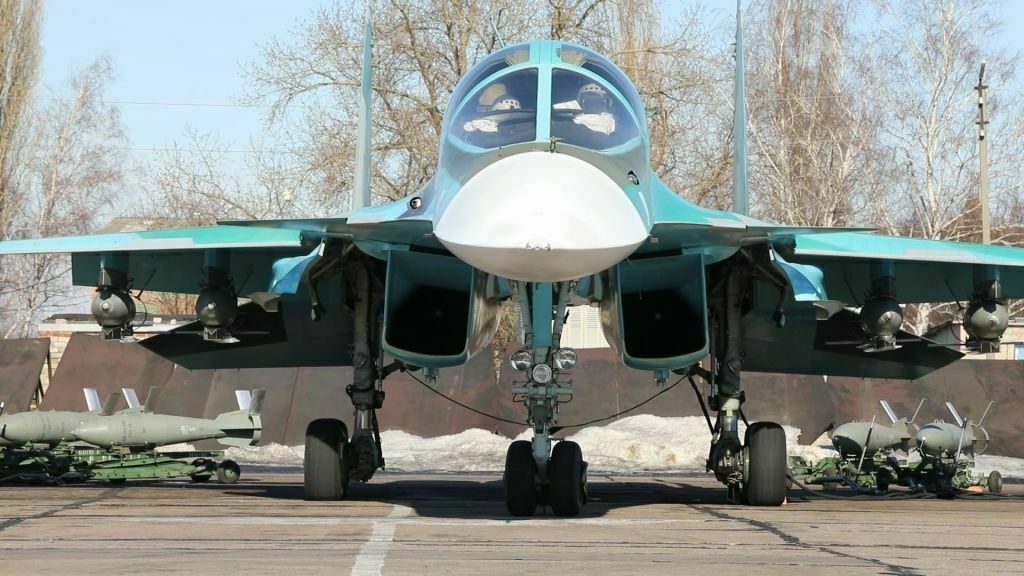
-
Orbán is once again against Ukraine
-
Russia ready to hold third round of peace talks with Ukraine, Putin says
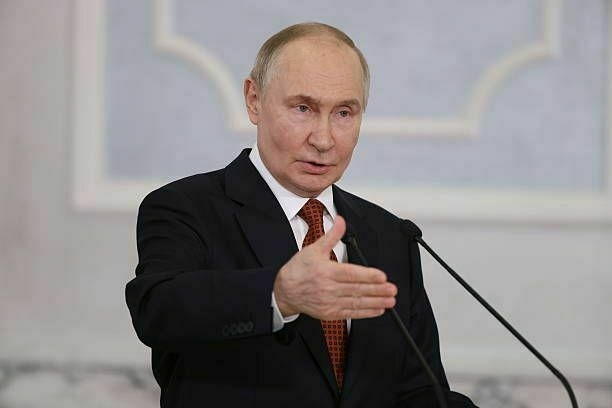
Russia is ready to hold a third round of peace talks on the war in Ukraine, Russian President Vladimir Putin told reporters on June 27, without specifying if he would directly participate in the negotiations.
“In general, we are ready for this (next round of peace talks), we need to coordinate the place and time,” Putin said.
Putin added that the talks could potentially be held in Istanbul but the details have not yet been worked out. He added that another round of talks may bring peace closer as the terms for peace outlined in the countries' peace memorandums remain “absolutely opposite."
The latest peace talks between Russia and Ukraine took place on June 2 in Istanbul, following an earlier meeting on May 16. Despite Ukraine’s insistence on a 30-day ceasefire, Russia has repeatedly rejected the offer, proposing only a temporary 2–3-day truce in limited areas to retrieve the bodies of fallen soldiers.
While no agreement on a comprehensive ceasefire has been reached, talks have led to a few major prisoner exchanges, including a 1,000-for-1,000 swap that took place in late May and a follow-up deal for up to 1,200 prisoners from each side.
Defense Minister Rustem Umerov said during a press briefing on June 26 that it was Ukraine’s goal to organize a direct meeting between President Volodymyr Zelensky and Putin during the next round of negotiation.
In previous rounds, Putin had failed to show in-person sending lower-level officials to the meeting instead — despite Zelensky’s willingness for in-person talks as well pressure from the United States.
On June 26, Turkish President Recep Tayyip Erdogan said Ankara is working to organize a meeting between Zelensky and Putin, with U.S. President Donald Trump potentially joining the talks.
Putin said on June 27 that it was “quite possible” that a meeting between himself and the U.S. president could take place. “We will be happy to prepare it,” he briefly added.
Zelensky and Trump met during the NATO summit on June 25, where the two leaders discussed battlefield developments, Kyiv’s need for additional air defense systems, and the potential for co-production of drones.
Zelensky has previously voiced openness to a trilateral meeting. On May 27, he told public broadcaster Suspilne that he was ready to sit down with both Trump and Putin.
Turkey previously hosted direct peace talks in March 2022 and has remained one of the few countries with open lines to both Kyiv and Moscow.
Putin under pressure to declare war on Ukraine, but experts say Russia isn’t readyDespite suffering over 1 million casualties, pounding Ukrainian cities nightly with missiles and drones, and committing countless war crimes, one startling fact about Russia’s full-scale invasion remains — Moscow has yet to officially declare war on Ukraine. In February 2022, Russian President Vladimir Putin described what he believed was going to be a swift victory and the capture of Kyiv within days as a “special military operation.” Nearly three-and-a-half years later, the Kremlin is stuck The Kyiv IndependentChris York
The Kyiv IndependentChris York